Physical Address
304 North Cardinal St.
Dorchester Center, MA 02124
| Fracture | Finding |
|---|---|
| Spine | |
| Jefferson | Ring fracture of C1 |
| Hangman's | Bilateral pedicle or pars fractures of C2 |
| Teardrop (flexion) | Unstable flexion fracture |
| Clay-shoveler's | Avulsion fracture of spinous process lower cervical, high thoracic spine |
| Chance | Horizontal fracture through soft tissues and/or bone of thoracolumbar spine |
| Burst | Compression fracture with disruption of the posterior vertebral body with retropulsion into the spinal canal |
| Face | |
| All Le Fort fractures involve the pterygoid plates | |
| Le Fort I | Floating palate |
| Le Fort II | Floating maxilla |
| Le Fort III | Floating face |
| Upper Extremity | |
| Hill-Sachs lesion (anterior dislocation) | Impaction fracture of posterolateral humeral head |
| Bankart lesion (anterior dislocation) | Fracture of anterior glenoid rim |
| Trough sign (posterior dislocation) | Linear impaction fracture of anterior humeral head |
| Reverse Bankart lesion (posterior dislocation) | Fracture of posterior glenoid rim |
| Monteggia fracture-dislocation | Ulnar fracture, proximal radial dislocation |
| Galeazzi fracture-dislocation | Radial fracture, distal radioulnar dislocation |
| Essex-Lopresti | Radial head fracture and distal radioulnar subluxation |
| Colles | Distal radius fracture, dorsal angulation |
| Smith | Distal radius fracture, volar angulation |
| Barton | Intraarticular distal radial fracture/dislocation through dorsal articular surface |
| Reverse Barton intraarticular distal radial fracture through volar articular surface | |
| Bennett | Fracture-dislocation of base of first metacarpal |
| Rolando | Comminuted Bennett fracture |
| Boxer's | 5th MCP shaft or neck fracture |
| Gamekeeper's thumb (skiers) | Ulnar collateral ligament injury of 1st MCP joint |
| Chauffeur's | Intraarticular fracture of radial styloid |
| Pelvis | |
| Duverney | Iliac wing fracture |
| Malgaigne | SI joint or sacrum and both ipsilateral pubic rami |
| Bucket-handle | SI joint or sacrum and contralateral pubic rami |
| Straddle | Fracture of both obturator rings (all four pubic rami) |
| Lower Extremity | |
| Segond | Avulsion fracture of lateral tibial condyle; associated with ACL injury |
| Bumper | Intraarticular fracture of tibial condyle |
| Pilon | Intraarticular comminuted distal tibia fracture |
| Tillaux | Salter-Harris III of lateral distal tibia (because of later epiphyseal fusion) |
| Triplane | Salter III/IV fracture of distal tibia |
| Wagstaffe-Le Fort | Avulsion of the medial margin distal fibula |
| Dupuytren | Fracture of fibula above tibiofibular ligament |
| Maisonneuve | Proximal fibular fracture and disrupted ankle mortise or medial malleolar fracture |
| Lover's | Calcaneal fracture |
| Jones (dancer's) | Fracture of proximal 5th metatarsal shaft |
| Lisfranc | Tarsometatarsal fracture-dislocation |
| March | Stress fracture of metatarsal neck |
Phases of healing:
Inflammatory phase
Torn periosteum
Blood clots in fracture line
Inflammatory reaction
Reparative phase
Granulation tissue replaces clot.
Periosteum forms immature callus.
Internal callus forms within granulation tissue.
Cartilage forms around fracture.
Remodeling phase
Woven bone in callus is replaced by compact bone (cortex) and cancellous bone (medullary cavity).
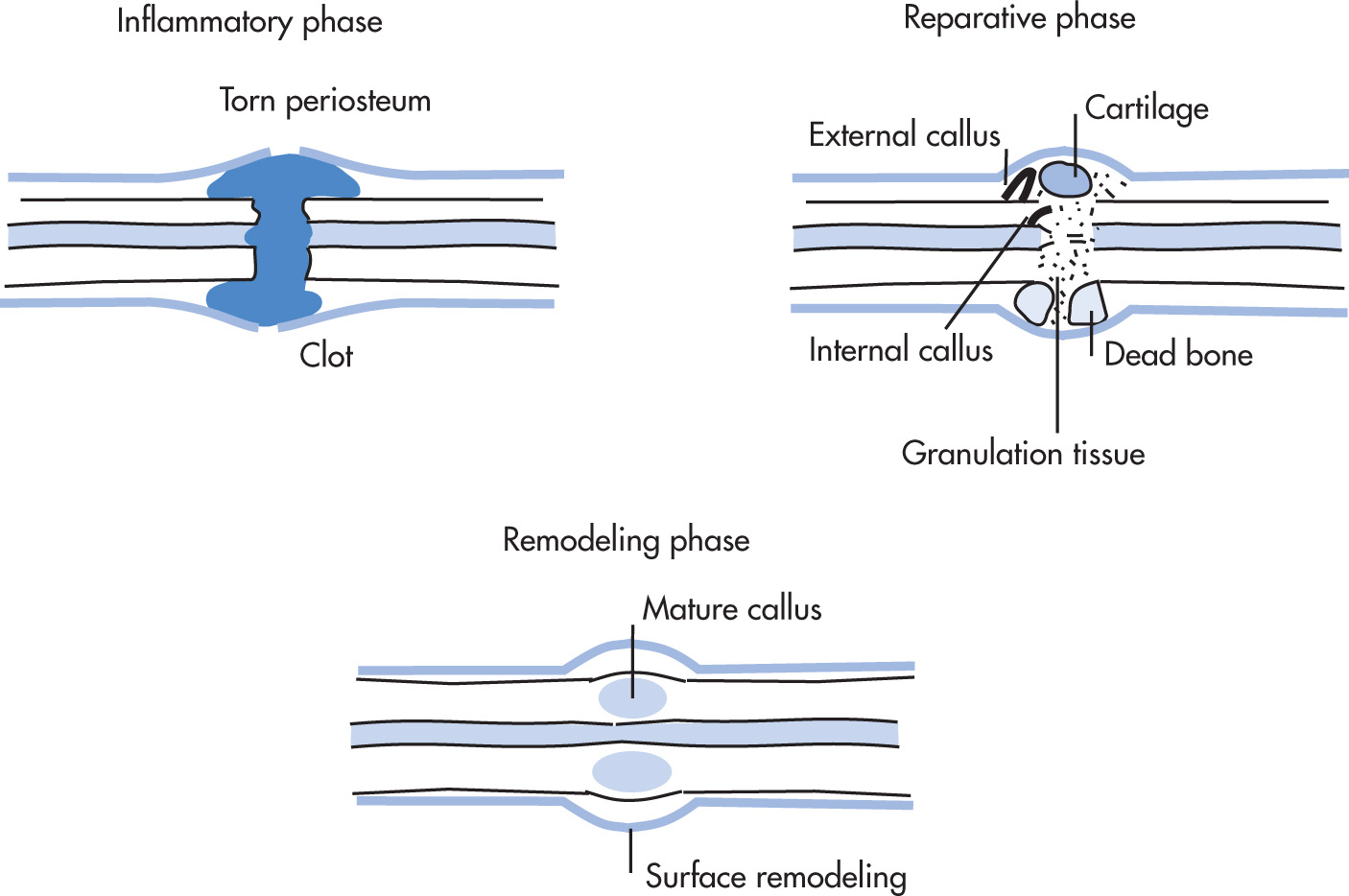
Anatomic site of fracture
In long bones, divide the shaft into thirds (e.g., fracture distal third of femur).
Use anatomic landmarks for description (e.g., fracture near greater tuberosity).
Pattern of fracture
Simple fracture: no fragments. Describe the direction of the fracture line: transverse, oblique, spiral, longitudinal
Comminuted fracture (more than two fragments): T-, V-, Y-shaped patterns, butterfly fragments, segmental
Complete or incomplete fractures
Apposition and alignment: defined in relation to distal fragments
Displacement (e.g., medial, lateral, posterior, anterior)
Angulation (e.g., medial, lateral, posterior, anterior)
Rotation (internal, external)
Overriding: overlap of fragments (bayonet apposition)
Distracted: separated fragments
Adjacent joints
Normal
Dislocation
Subluxation
Intraarticular extension of fracture line
Stress fractures:
Fatigue fracture: abnormal muscular stress applied to normal bone (e.g., march fracture)
Insufficiency fracture: normal muscular stress applied to abnormal bone (e.g., osteoporotic vertebral fracture)
Pathologic fracture: fracture superimposed on underlying bone disease
Intraarticular fracture: fracture line extends into joint
Salter-Harris fracture: fractures involving growth plate
Pseudofracture: fissure like defects in osteomalacia (Looser zones)
Occult fracture: suspected but nonvisualized fracture on plain radiograph; demonstrated by 99m technetium (Tc) methylene diphosphonate (MDP) scintigraphy or magnetic resonance imaging (MRI)
Hairline fracture: nondisplaced fracture with minimal separation
Avulsion fracture: fragment pulled away from bone at tendinous and ligament insertion (commonly at tuberosity)
Apophyseal fracture: at growth centers such as ischial tuberosity and medial epicondyle; commonly avulsion fractures
Bone is composed of calcium hydroxyapatite on a matrix of collagen and other proteins. Thick outer cortex surrounds cancellous (or trabecular) bone, and both contribute to bone strength. Bone is covered by periosteum, except at the joints, where it is covered with cartilage. Normal bone undergoes constant balanced turnover, bone resorption is facilitated by osteoclasts, bone production by osteoblasts. As per Wolff law, an increase in bone stress shifts the balance toward bone production. Vice versa, decreased bone loading leads to decreased bone mass.
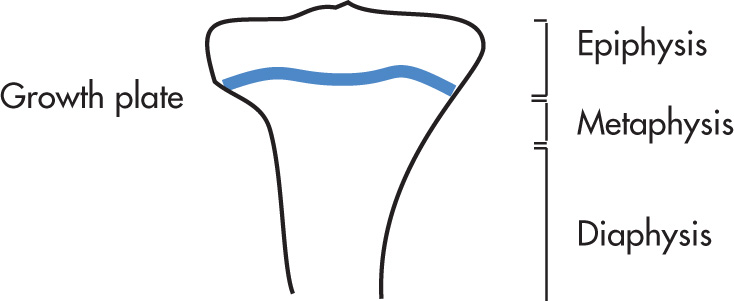
Epiphysis
Metaphysis
Diaphysis
Synovial joint (diarthrosis)
Appendicular skeleton
Facet joints of spine
Atlantoaxial joints
Lower two-thirds of sacroiliac (SI) joints
Acromioclavicular (AC) joint
Uncovertebral joints
Cartilaginous joint (amphiarthrosis)
Synchondroses (temporary: physis; permanent: ribs, first sternocostal joint)
Pubic symphysis
Intervertebral disks
Fibrous joint (synarthrosis)
Tibiofibular and radioulnar syndesmosis
Cranial sutures
Gomphoses (dentoalveolar joints)
Superior portions of SI joints
In contradistinction to fibrous and cartilaginous joints, synovial joints allow wide ranges of motion and are classified according to axes of movement. The articular cartilage is hyaline. The most superficial layer has collagen fibrils parallel to the surface with microscopic pores to allow passage of electrolytes. This is also referred to as the armor plate. Deeper in the cartilage, collagen fibrils are arranged in arcades to give flexibility and allow for compression. Proteoglycans within the cartilage bind water to give a cushion effect.
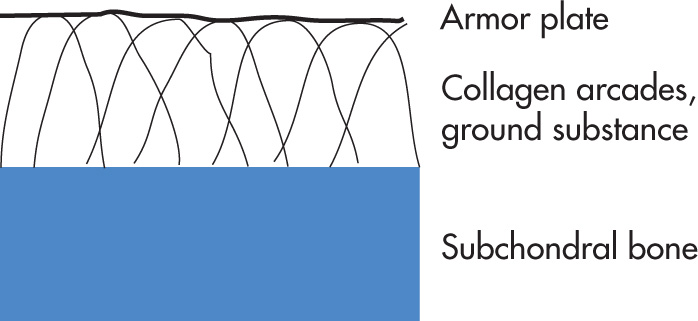
Cartilaginous joints are covered with fibrocartilage, and allow for limited range of motion. There is no synovial lining and there is often a central disk.
Fibrous joints are the strongest joints, allowing almost no motion. Fibrous tissue is between bones.
Immediate
Hemorrhage, shock
Fat embolism
Acute ischemia (5 Ps : p ulselessness, p ain, p allor, p aresthesia, p aralysis)
Spinal cord injury, epidural hematoma
Delayed
Nonunion
Osteoporosis caused by disuse
Secondary osteoarthritis (OA)
Myositis ossificans
Osteomyelitis
Osteonecrosis
Sudeck atrophy
Volkmann ischemic contracture
Reduction
Closed: skin intact; may be performed in surgery under general anesthesia
Open: requires exposing the fracture site in surgery
Fixation
Internal: using fixation devices such as plates, screws, rods; a subsequent operation is usually necessary to remove hardware.
External: cast or external fixator
Intramedullary rods: most of the intramedullary rods are hollow, closed nails; proximal and distal interlocking screws prevent rotation and shortening of bone fragments.
Kirschner wires (K-wires): unthreaded segments of wires drilled into cancellous bone; if more than one wire is placed, rotational stability can be achieved; the protruding ends of the K-wire are bent to prevent injury; K-wires are most frequently used for:
Provisional fixation
Fixation of small fragments
Pediatric metaphyseal fractures
Cerclage wires are used to contain bone fragments.
Staples are commonly used for osteotomies.
Plates
Nails
Screws
| Type of Injury | Condition | Stability a |
|---|---|---|
| Flexion | Anterior subluxation | Stable b |
| Unilateral facet dislocation | Stable | |
| Bilateral facet dislocation | Unstable | |
| Wedge compression fracture | Stable b | |
| Flexion teardrop fracture | Unstable | |
| Clay-shoveler's fracture | Stable | |
| Extension | Posterior arch of C1 fracture | Stable |
| Hangman's fracture | Unstable | |
| Laminar fracture | Stable | |
| Pillar fracture | Stable | |
| Extension teardrop fracture | Stable | |
| Hyperextension dislocation-fracture | Unstable | |
| Compression | Jefferson fracture | Unstable |
| Burst fracture | Stable | |
| Complex | Odontoid fractures | Unstable |
| Atlantooccipital disassociation | Unstable |
a Stability is a function of ligamentous injury. Plain radiographs in neutral position allow one to infer instability when certain fractures or dislocations are present. However, stability may not be inferred with 100% accuracy. The anterior subluxation injury in which radiographs may appear within normal limits is an example. Clinical judgment is necessary to decide whether to do nothing, obtain flexion/extension radiographs, or obtain a magnetic resonance imaging (MRI) scan.
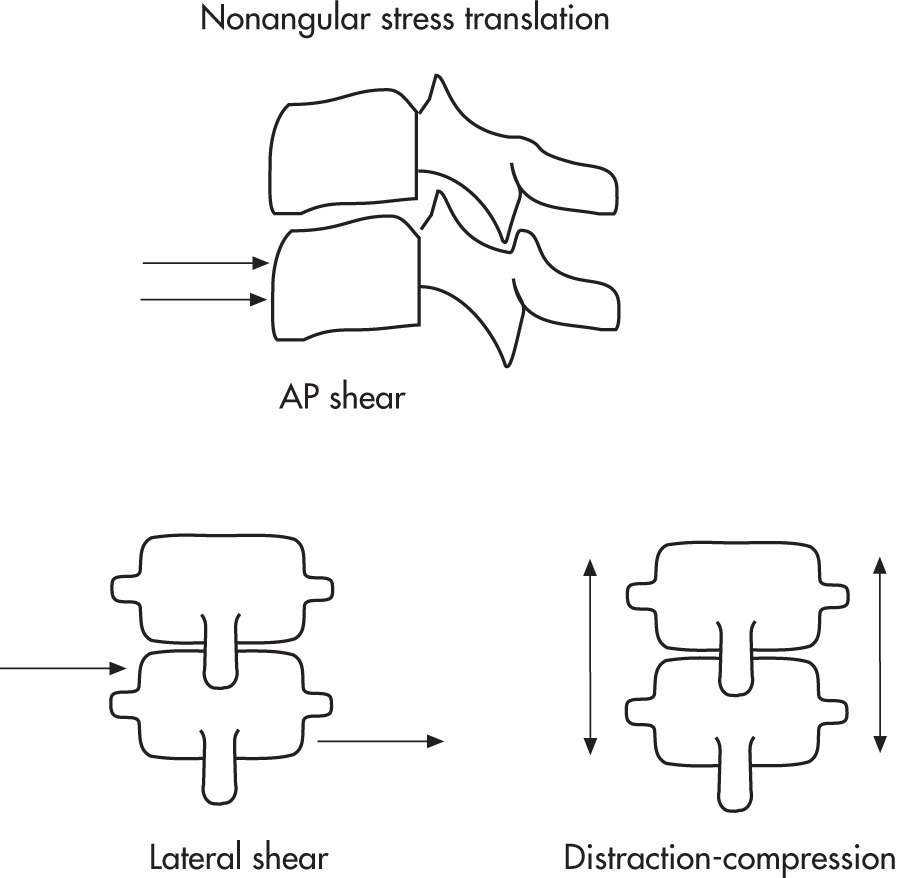
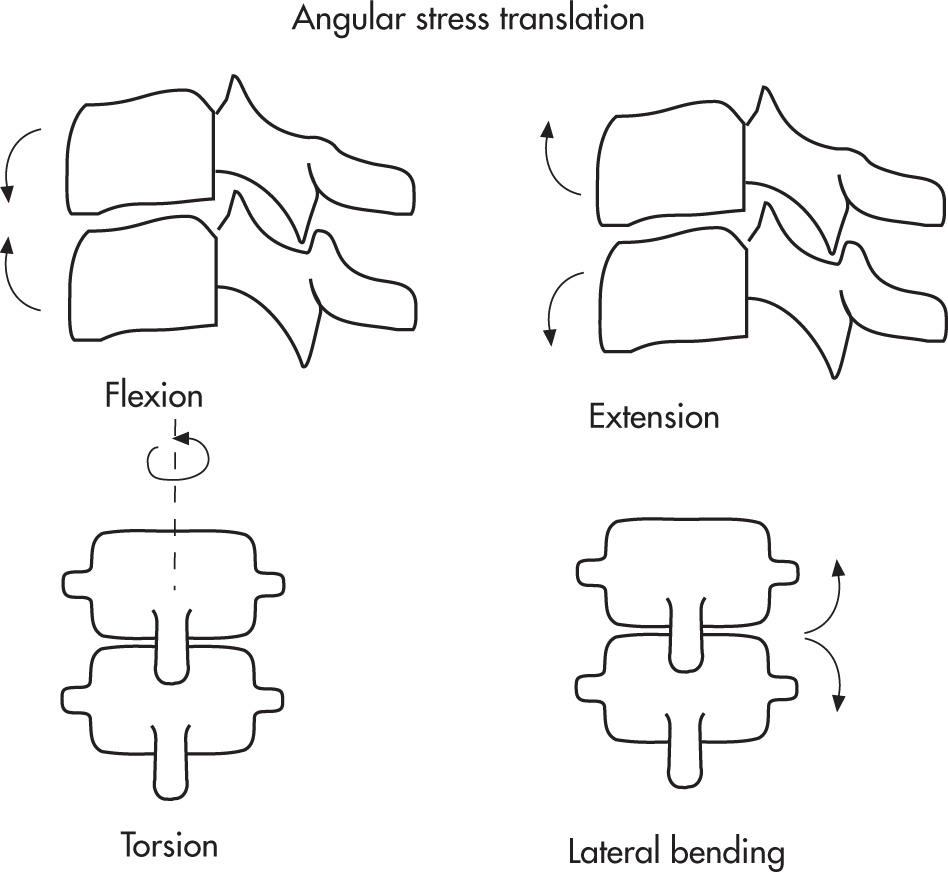
20% of spinal fractures are multiple.
5% of spinal fractures are at discontinuous levels.
Spinal cord injury occurs:
At time of trauma, 85%
As a late complication, 15%
Cause of spinal fractures
Motor vehicle accident (MVA), 50%
Falls, 25%
Sports related, 10%
Most spinal fractures occur in upper (C1–C2) or lower (C5–C7) cervical spine and thoracolumbar (T10–L2) region.
Are all seven cervical vertebrae well seen? If not, obtain additional views such as swimmer's view, computed tomography (CT), etc.
Is cervical lordosis maintained? If not, consider:
Positional
Spasm
Fracture/injury
Evaluate five parallel lines for stepoffs and/or discontinuity.
Prevertebral soft tissues
C3–C4: 5 mm from vertebral body is normal (nonportable radiograph)
C4–C7: 20 mm from vertebral body is normal (not as reliable)
Contour of soft tissues is as important as absolute measurements; a localized bulging anterior convex border usually indicates pathology.
Anterior longitudinal line
Posterior longitudinal line
Spinolaminar line
Posterior spinous process line
Inspect C1–C2 area.
Atlantodental distance (normal distance indicates intact transverse atlantal and alar ligaments)
Adults: <3 mm is normal.
Children: <5 mm is normal.
Base of odontoid may not be calcified in children (subdental synchondrosis).
Inspect disk spaces.
Narrowing of disk spaces?
Transverse processes: C7 points downward, T1 points upward.
Pearls for C-spine plain radiographs in children:
Atlantoaxial distance <5 mm is normal (ligamentous laxity, compare with <3 mm in adults).
Pseudo-Jefferson fracture: up to 6 mm displacement of the lateral masses of C2 can be seen on open-mouth view up to 7 years age.
On flexion views, widening of the interspinous distance between C1 and C2 is normal.
Lateral pseudoluxation of C2–C3 and to a lesser extent C3–C4. If posterior cervical line is within 1 mm in both flexion and extension, then no true injury is present.
Absence of normal cervical lordosis can be seen up to 16 years age.
Wedging of cervical vertebral bodies up to 3 mm, especially C3, can be normal.
Do not confuse ossification centers with open synchondroses (smooth, regular structures with subchondral sclerotic lines) with fractures (irregular, not sclerotic acutely). Synchondroses at C2 may simulate type 3 dense fracture.
Apparent prevertebral soft tissue swelling may be due to expiration and/or flexion, repeat image in inspiration and slight extension.
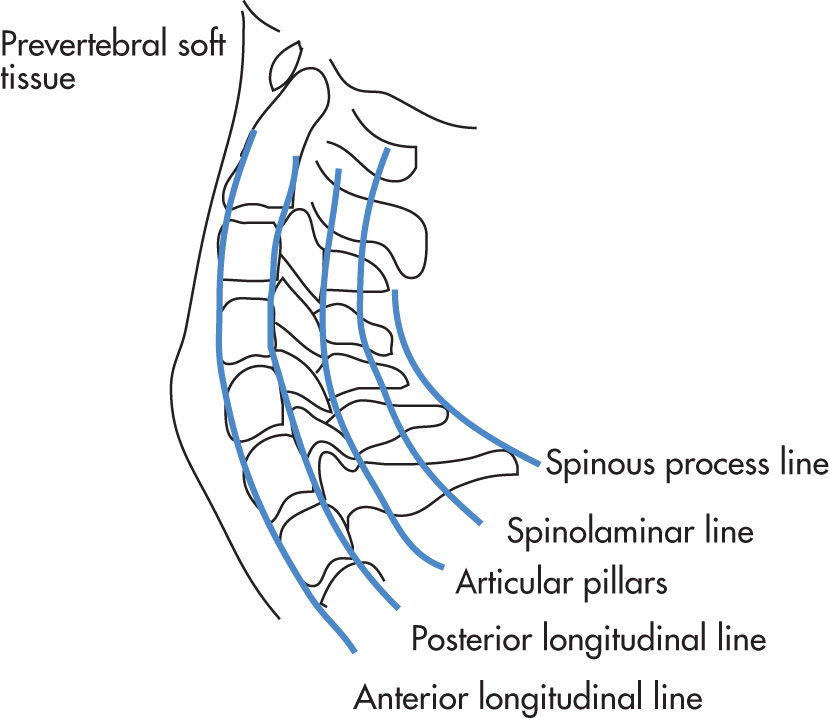
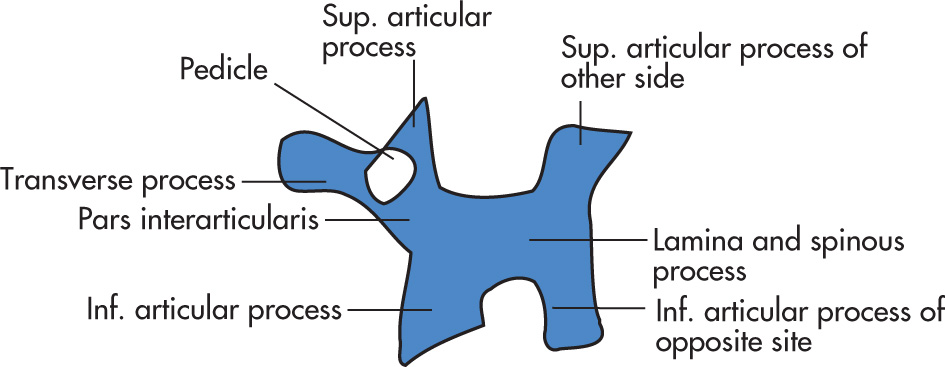
Most suspected C-spine fractures are followed with thin-section CT with reformation for most accurate evaluation.
Patients with history/examination highly suggestive of cervical spine injury (high-speed accident) proceed directly to CT, followed by an out-of-collar lateral to clear cervical spine.
All individuals with signs/symptoms of cord injury require MRI.
It is also prudent to obtain CT in patients with unexplained prevertebral soft tissue swelling.
Compression force to C1 that usually results from blow to the vertex of the head (diving injury).

Consists of unilateral or bilateral fractures of both the anterior and posterior arches of Cl. Treatment is halo placement for 3 months.
Key radiographic view: anteroposterior (AP) open-mouth
Displacement of C1 lateral masses
<2 mm bilateral is always abnormal in adults.
<1–2 mm or unilateral displacement can be due to head tilt/rotation.
CT required for:
Defining full extent of fracture
Detecting fragments in spinal cord
Various mechanisms: Anderson/D'Alonzo classification:
Type I: fracture in the upper part of the odontoid (potentially unstable; rare fracture).
Type II: fracture at base of the odontoid (unstable); highest rate of nonunion because fracture is above the accessory ligament and vascular supply.
Type III: fracture through base of odontoid into body of axis; best prognosis for healing because of larger surface area (unstable).

Anterior tilt of odontoid on lateral view is highly suggestive of fracture.
Plain radiograph tomograms or CT with reformations are helpful to delineate fracture line.
Prevertebral soft tissue swelling (may be the only sign)
Os odontoideum (type II)
Congenital or posttraumatic
May be mechanically unstable
Os terminale (type I)
Ossification center that normally fuses by age 12, but may remain persist unfused simulating a type I dens fracture.
Hyperextension and traction injury of C2.
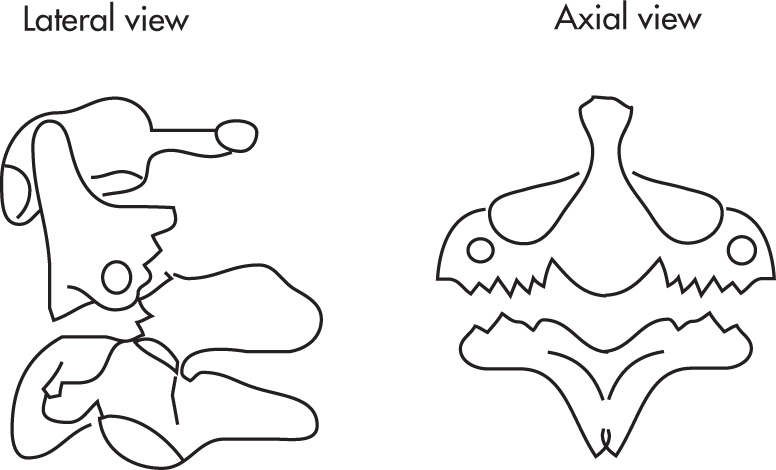
Hanging
MVA (chin hits dashboard)
Best demonstrated on lateral view
Bilateral C2 pars (common) or pedicle (less common) fractures
Anterior dislocation or subluxation of C2 vertebral body
Avulsion of anterior inferior corner of C2 (ruptured anterior longitudinal ligament)
Prevertebral soft tissue swelling
Same mechanism as in Jefferson fracture but located at C3–C7. Injury to spinal cord (displacement of posterior fragments) is common. All patients require CT to evaluate full extent of injury, to detect associated fractures, and to identify fragments in relation to spinal canal.
The most severe C-spine injury. Results from severe flexion force and presents as clinical “acute anterior cord syndrome” (quadriplegia, loss of anterior column senses, retention of posterior column senses). Completely unstable.
Teardrop fragment is major shear fragment from anteroinferior vertebral body.
All ligaments are disrupted.
Posterior subluxation of vertebral body
Bilateral subluxated or dislocated facets
Severe compromise of spinal canal secondary to subluxation of body and facets
Not to be confused with:
Extension teardrop fracture (stable avulsive injury)
Burst fracture (stable comminuted fracture of centrum with variable neurologic involvement)
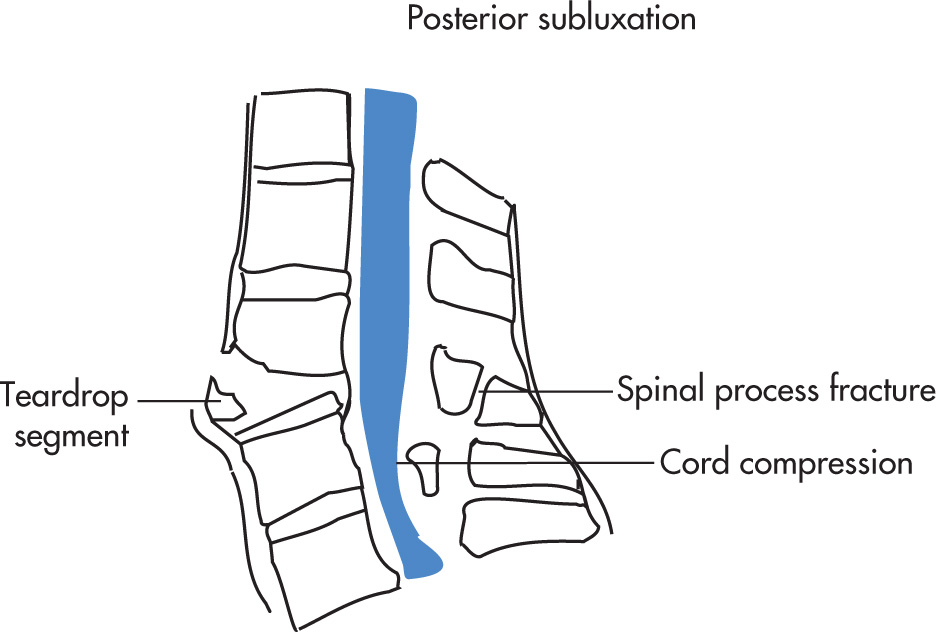
Oblique avulsive fracture of a lower spinous process, most commonly at C6–T1 levels (C7 > C6 > T1). Caused by powerful hyperflexion (shoveling).
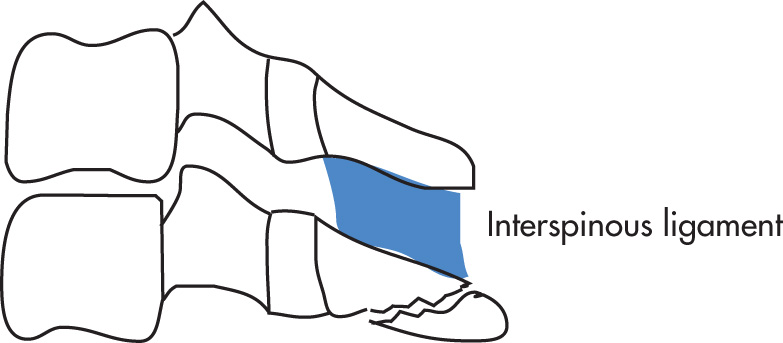
Fracture through spinous process, best seen on lateral view
If C6–C7 is not demonstrated on lateral view, obtain swimmer's view and/or CT.
AP view: ghost sign (double-spinous process on C6–C7 caused by caudal displacement of the fractured tip of the spinous process)
Compression fracture resulting from flexion. Most fractures are stable.
Loss of height of anterior vertebral body
Buckled anterior cortex
Anterosuperior fracture of vertebral body
Differentiate from burst fracture
Lack of vertical fracture component
Posterior cortex intact
Avulsion fracture of anteroinferior corner of the axis resulting from hyperextension.
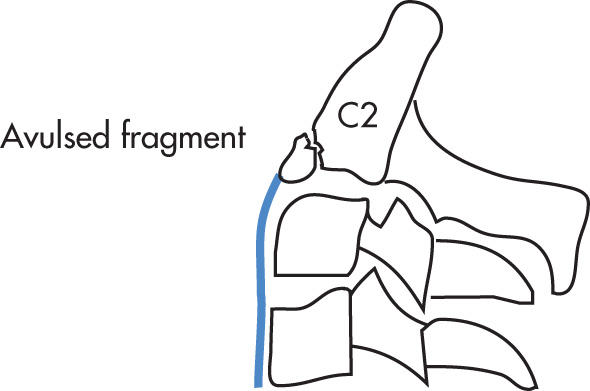
Teardrop fragment: avulsion by the anterior longitudinal ligament
Vertical height of fragment ≥ horizontal width
Do not confuse with limbus vertebra, which are a result of herniation of the nucleus pulposus through the endplate beneath the ring apophysis. Appear well corticated.
Results from extreme flexion of head and neck without axial compression.
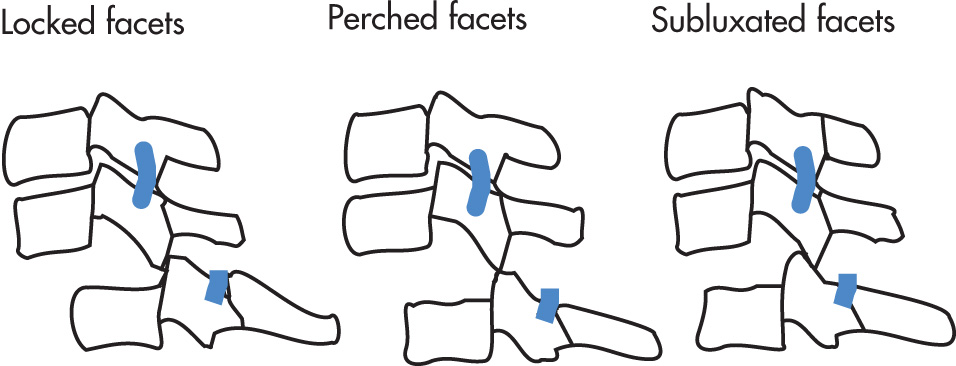
Complete anterior dislocation of the affected vertebral body by half or more of the vertebral body AP diameter
Batwing or bowtie configuration of locked facets
Disruption of posterior ligament complex, intervertebral disk, and anterior longitudinal ligament
Results from simultaneous flexion and rotation.
Anterior dislocation of vertebral body less than half the AP diameter of the vertebral body
Evidence of discordant rotation above and below involved level
Disrupted “shingles-on-a-roof” on oblique view
Facet within intervertebral foramen on oblique view
Disrupted posterior ligament complex
Best demonstrated on lateral and oblique views
Anterior subluxation occurs when the posterior ligament complex is disrupted. Radiographic diagnosis can be difficult because muscle spasm may cause similar findings. Initially stable. Delayed instability occurs in 20%–50%.
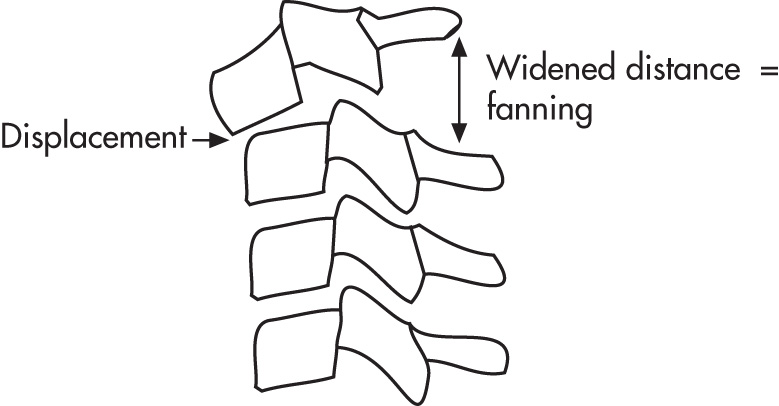
Localized kyphotic angulation
Widened interspinous/interlaminar distance (fanning)
Posterior widening of disk space
Subluxation at facet joints
Anterior vertebral body may be displaced.
In equivocal findings, voluntary flexion/extension views are helpful.
Results from severe circular hyperextending force (e.g., impact on forehead). Characteristically results in anterior vertebral displacement, a finding more commonly seen in flexion injuries. Unstable.
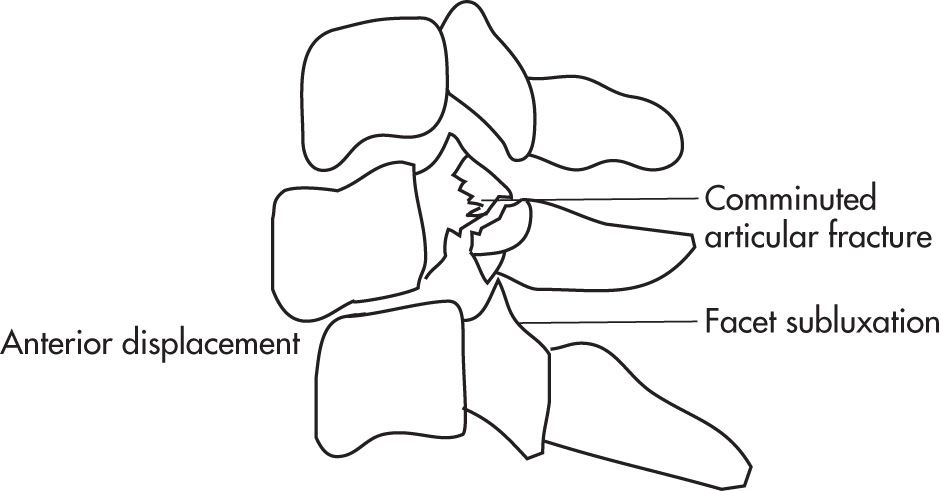
Mild anterior vertebral displacement
Comminuted articular mass fracture
Contralateral facet subluxation
Disrupted anterior longitudinal ligament and partial posterior ligamentous disruption
Complex mechanism of injury. Complete dislocation is usually fatal.
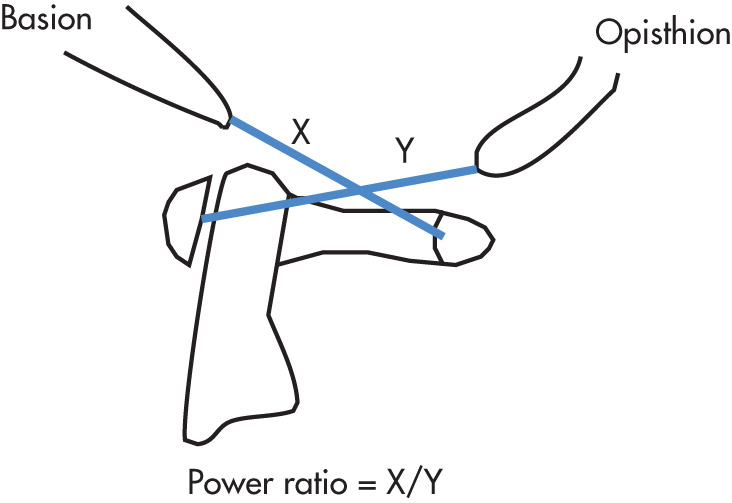
Prevertebral soft tissue swelling; a gap of more than 5 mm between the occipital condyles and the condylar surface of the atlas is highly suggestive of craniocervical injury.
Wackenheim clivus line: a line drawn along the posterior aspect of the clivus toward the odontoid process. An abnormality is suspected when this line does not intersect or is tangential to the odontoid process.
The traditional methods used to identify occipitoatlantal articulation injury included the power ratio (X/Y, see Fig. 5.17 ) and the “X” line of Lee. Each is dependent on identifying the opisthion and the spinolaminar line of C1. Anatomic variation and inconsistent visualization preclude consistent use of these methods.
The current method uses the basion-axial interval (BAI) and is an easy and reliable method for assessing the occipitoatlantal relationship in patients of all ages. BAI is the distance between the basion and upward extension of the posterior axial line. Normally the BAI should not exceed 12 mm as determined on a lateral radiograph of the cervicocranium obtained at a target radiograph distance of 1 meter.
The vertical basion-dens distance should also be <12 mm.
Anterior dissociation is more common.
Posterior dissociation (subluxation) can be very subtle, especially if partial.
In atlantoaxial fixation ( Fig. 5.18 ), the normal rotation of C1 on C2 cannot occur and the abnormal relationship between the atlas and the axis becomes fixed. Fielding and Hawkins have classified atlantoaxial rotatory subluxation into four categories:
Type I, the most common type, demonstrates no displacement of C1.
Type II demonstrates 3–5 mm of anterior displacement of C1 and is associated with abnormality of the transverse ligament.
Type III demonstrates over 5 mm of anterior displacement of C1 on C2 and is associated with deficiency of the transverse and alar ligaments.
Type IV, a rare entity, demonstrates C1 displacement posteriorly.
Occipital condyle fracture ( Fig. 5.19 )
Often requires CT for diagnosis (coronal views). May involve the hypoglossal canal or jugular foramen.
Unstable if avulsion of the alar ligament attachment site.
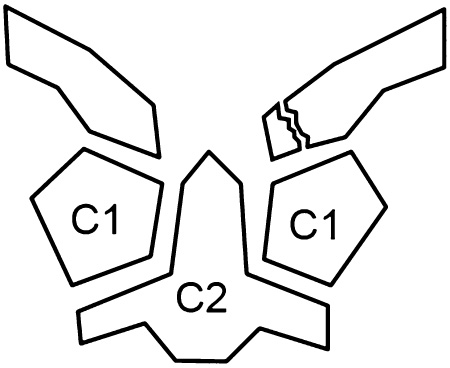
Longus colli muscle calcific tendinopathy ( Fig. 5.20 )
Calcium hydroxyapatite deposition leads to an inflammatory response.
Lateral C-spine view or CT shows amorphous calcification of the longus colli muscle tendons at the level C1–C2, often with small retropharyneal/prevertebral effusion.
Do not mistake for retropharyngeal abscess or trauma.
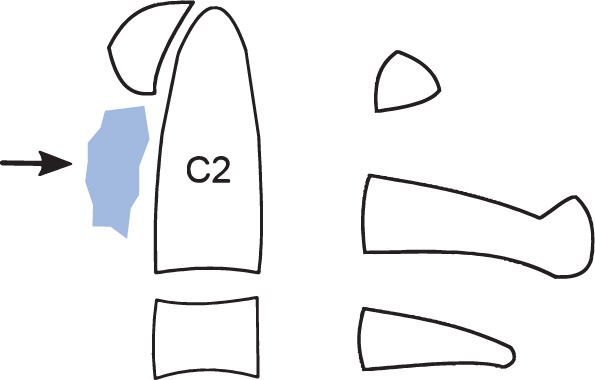
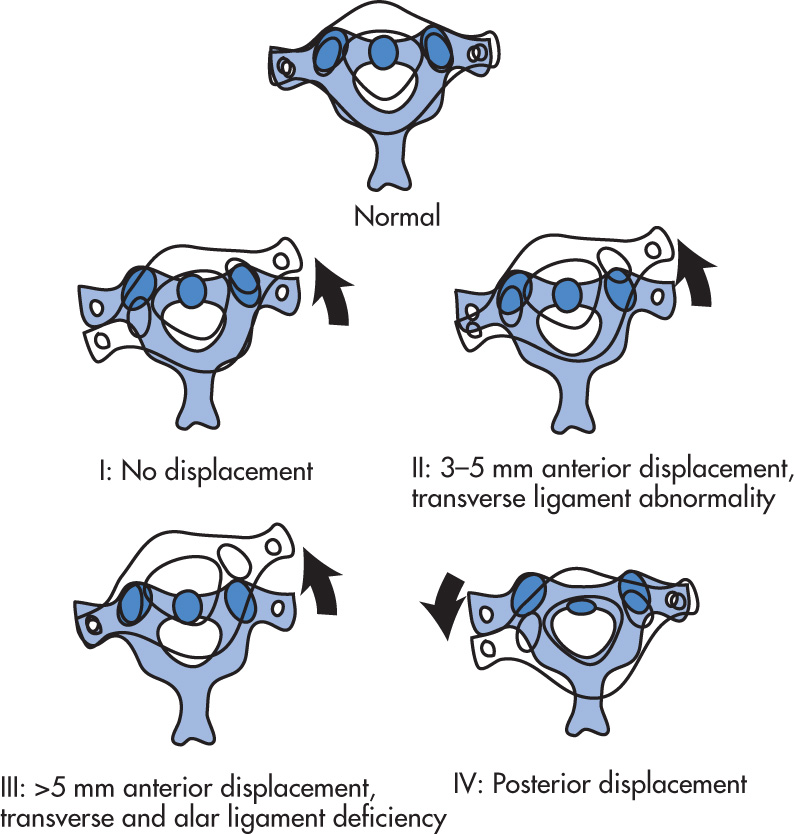
Most fractures occur at thoracolumbar junction (90% at T11–L4). All patients should have CT except for patients with:
Stable compression fractures
Isolated spinous or transverse process fractures
Spondylolysis
Widened interpedicular distance
Paraspinal hematoma
Unstable fractures:
Compression fracture >50%
Widened interlaminar space
Disrupted posterior elements
All fracture-dislocations
Classified by mechanism or injury:
Compression or wedge fractures: anterior or lateral flexion
Wedge-shaped deformity of vertebral body
Decreased vertebral body height
Burst fracture: axial compression
Comminution of vertebral body
Bone fragments in spinal canal are common.
Chance fractures (lap seatbelt fracture, usually at L2 or L3 [ Fig. 5.21 ]): distraction from anterior hyperflexion across a restraining lap seatbelt
Horizontal splitting of vertebra
Horizontal disruption of intervertebral disk
Rupture of ligaments
More than 50% of patients have associated small bowel and colon injuries (obtain abdominal CT).
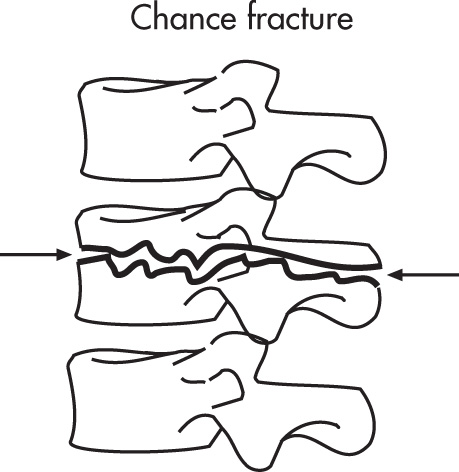
Fracture-dislocations: combined shearing and flexion forces
Spinal cord injury is common. Minor fractures
Transverse process fractures
Spinous process fractures
Pars interarticularis fractures
Defect in the pars interarticularis (neck of the “Scottie dog”). Chronic stress fracture with nonunion. Typically in adolescents involved in sports. Most commonly at the L4 or L5 level.
Separation of pars interarticularis
Spondylolisthesis common in bilateral spondylolysis
If patient looks to right, the left pars is visualized by X-ray.
Oblique view is usually diagnostic.
CT or single photon emission computed tomography (SPECT) may be helpful in confirming diagnosis.
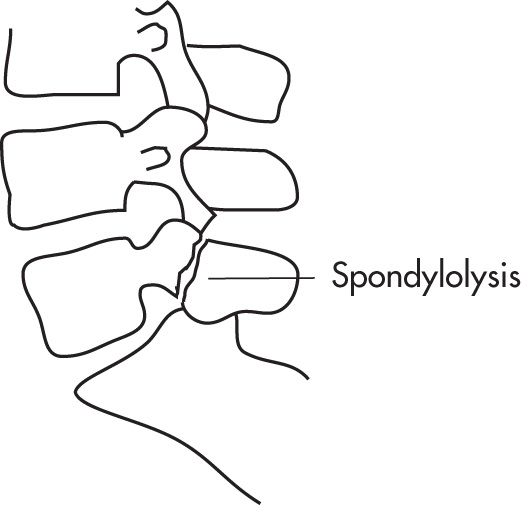
Ventral subluxation of a vertebral body as a result of bilateral pars defects.
Four grades based on degree of anterior displacement
95% of spondylolisthesis occurs at L4–L5 and L5–S1.
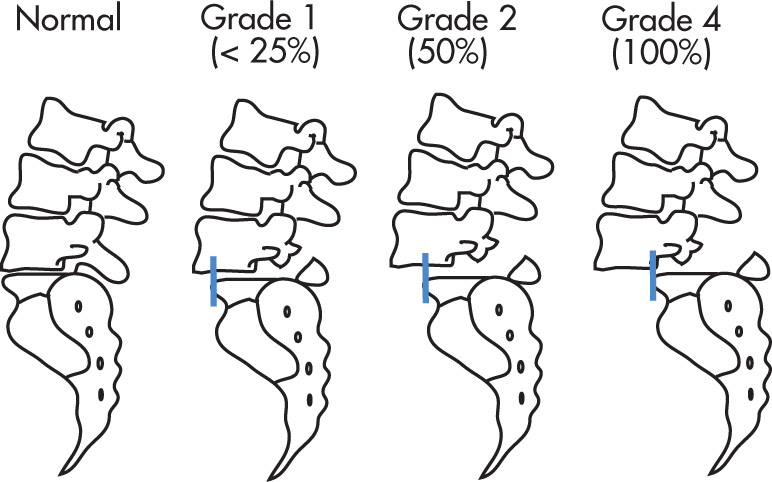
Secondary to degenerative disk disease and/or apophyseal degenerative joint disease (DJD). Use spinous process sign to differentiate from true spondylolisthesis. In true spondylolisthesis, the spinous process stepoff is above the level of vertebral slip; whereas in pseudospondylolisthesis, the stepoff is below the level of the slip.
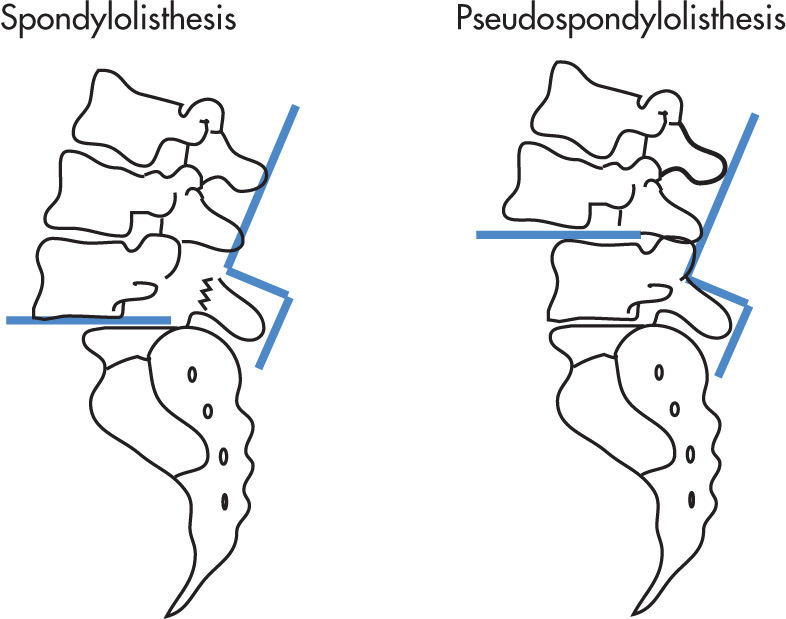
| General Category | Types | Need for CT |
|---|---|---|
| Orbital | Pure blow-out | Yes |
| Impure blow-out | Yes | |
| Blow-in | Yes | |
| Zygoma | Tripod fracture | Yes |
| Isolated zygomatic arch | No | |
| Nasal | Nondisplaced | No |
| Comminuted | Variable | |
| Nasal-orbital-ethmoid | Yes | |
| Septal fracture/dislocation | Yes | |
| Maxillary | Dentoalveolar | Yes |
| Sagittal | Yes | |
| Le Fort fractures | Yes | |
| Craniofacial (smash fractures) | Central craniofacial | Yes |
| Lateral craniofacial | Yes | |
| Frontal sinus | Yes | |
| Mandibular | Defined by site | Variable |
| Flail mandible | Variable |
Facial radiographs are rarely obtained for facial fractures. Thin-section CT with reformation is the preferred method of evaluation.
Incidence: nasal fractures > zygoma > other fractures
Facial series:
Waters view: three lines of the “elephant” should be traceable.
Maxillary sinuses
Orbital floor and rim
Nasal septum zygoma
Caldwell view
Orbital rim
Medial orbital wall
Sphenoid wings
Lateral view
Paranasal sinuses
Pterygoid plates
Towne view
Mandible
Base view (C-spine must be cleared first)
Zygoma
Mandible
Facial series is not adequate for nasal fractures:
Lateral (coned and soft tissue technique) views
Waters view
Occlusal view
Mandibular fractures require specific mandibular series:
Lateral, Towne, bilateral oblique views
Direct signs of fracture:
Cortical disruption, overlap, displacement
Indirect signs of fracture:
Asymmetry
Soft tissue swelling
Sinus abnormality (opacification, polypoid mass, air-fluid levels)
Orbital emphysema
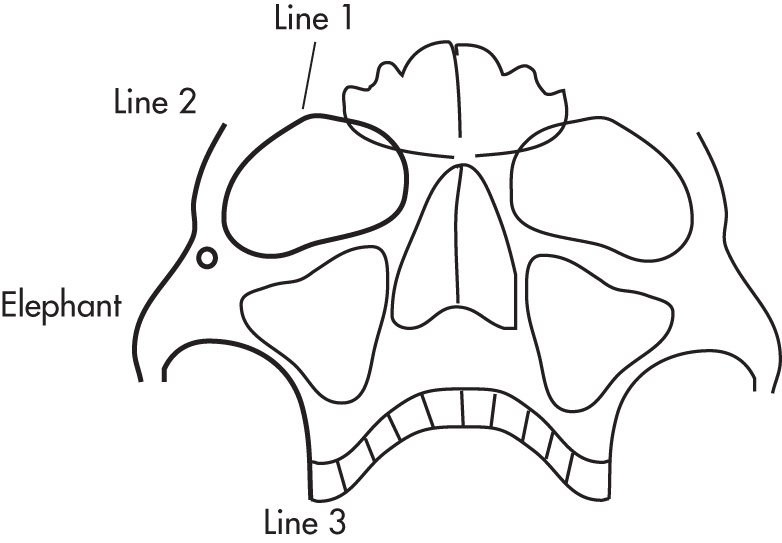
Isolated fracture of the orbital floor or less commonly the medial wall; the orbital rim is intact. Mechanism: sudden increase in intraorbital pressure (e.g., baseball, fist).
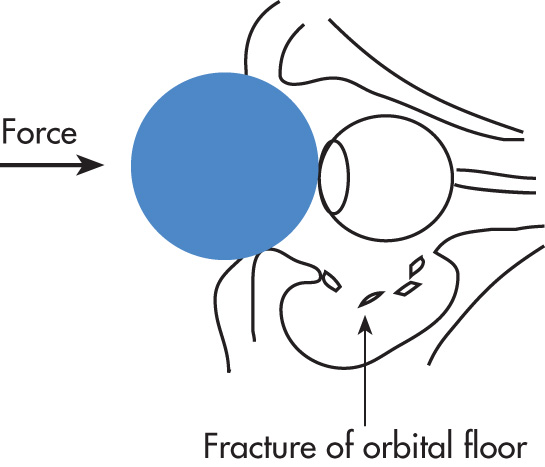
Diplopia on upward gaze (inferior rectus muscle entrapment)
Enophthalmos (may be masked by edema)
Displacement of bone fragments into maxillary sinus (trap door sign)
Opacification of maxillary sinus (hematoma)
Orbital emphysema
Caldwell and Waters views best demonstrate fractures.
Using CT, evaluate for muscle entrapment and orbital content herniation.
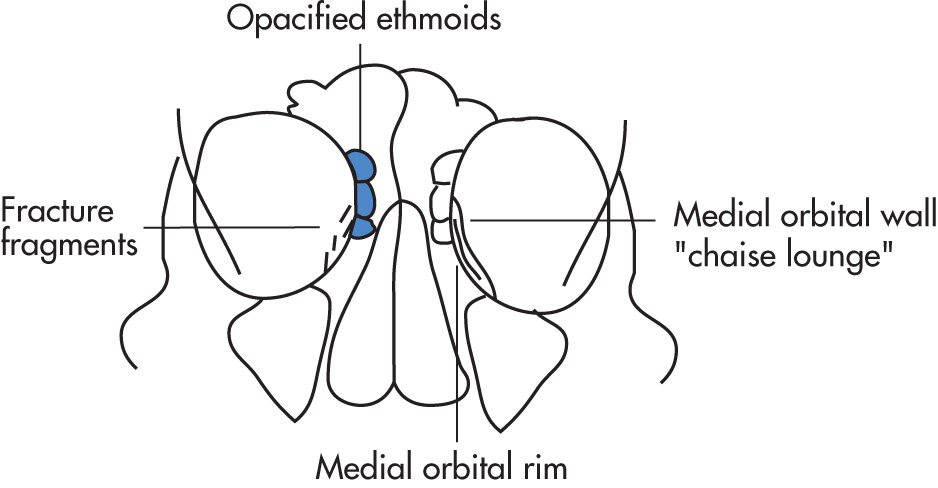
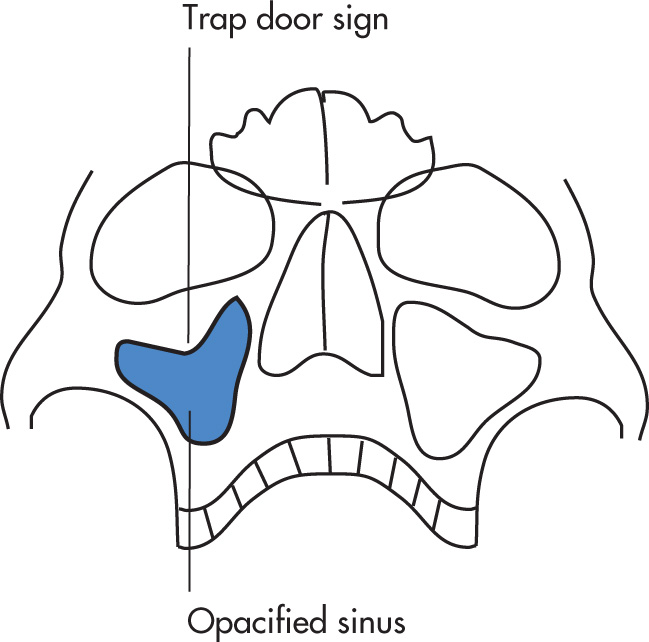
Associated with fracture of orbital rim and other facial fractures.
Impact to frontal bone causes blow-in of orbital roof. Associated with craniofacial fractures and frontal lobe contusion.
Isolated nasal fractures are linear and transverse, result from a direct frontal impact, and usually occur in the lower one-third of the nasal bone. More complex fractures result from lateral blows or more severe trauma and are often accompanied by other facial fractures.
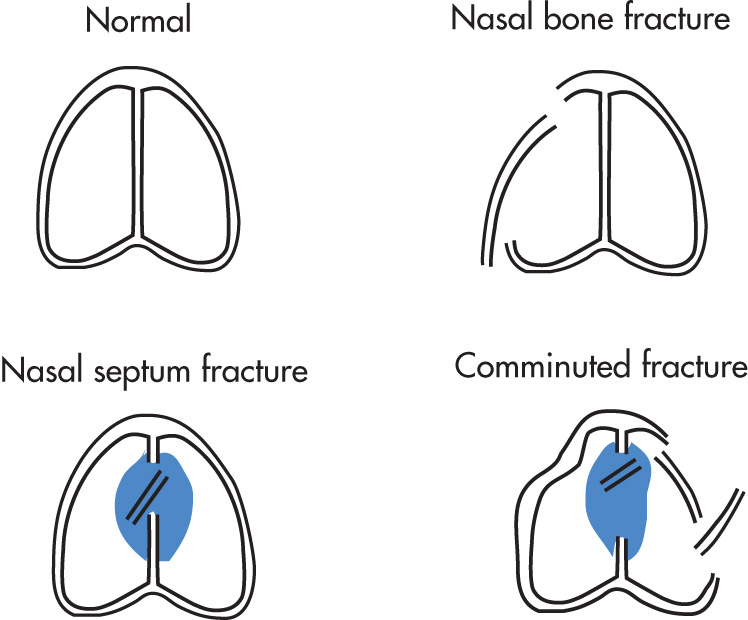
Most fractures are transverse and are depressed or displaced.
Dislocation of septal cartilage is diagnosed by occlusal view or CT.
Anterior nasal spine fracture is best evaluated by occlusal view.
Do not mistake sutures and nasociliary grooves for fractures.
The type of fracture depends on the site of impact. Most fractures are multiple and bilateral. The most common type of mandibular fracture is an ipsilateral fracture through the body of the mandible with a contralateral angle subcondylar fracture. Fractures typically occur in:
Body (areas of weakness include mental or incisive foramen)
Angle
Subcondylar region (condylar neck)
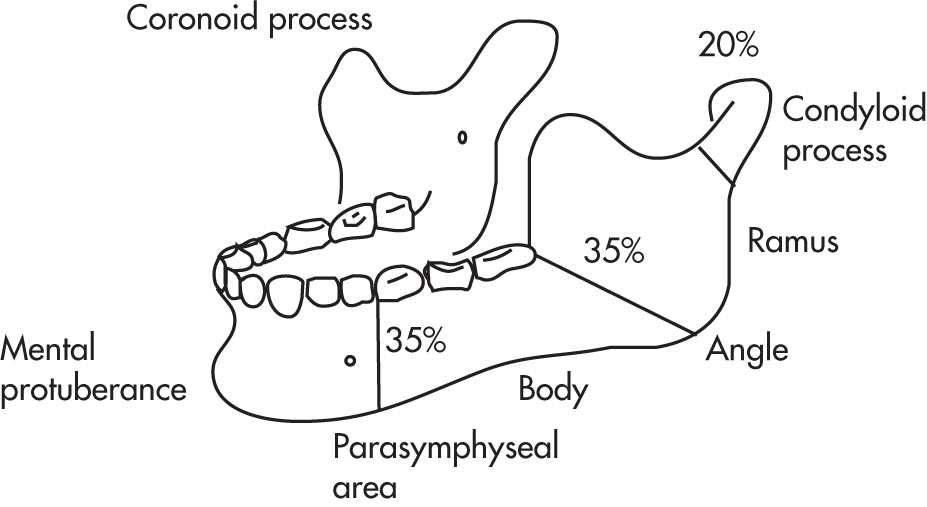
Symphysis fracture with bilateral subcondylar, angle, or ramus fracture. Tongue may prolapse and obstruct airway.
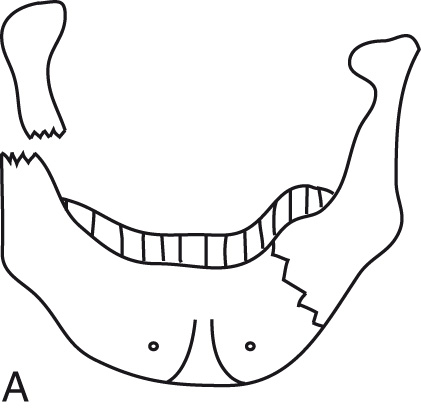
Best view to demonstrate zygoma fracture is the base view to demonstrate the “jug handle.”
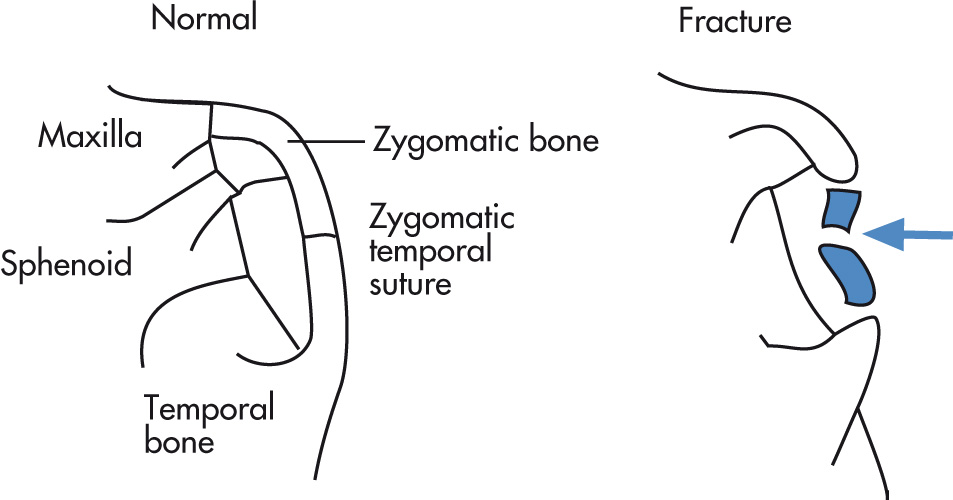
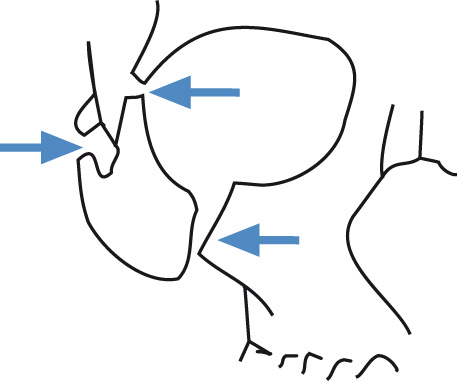
Simple fractures of the zygomatic arch are less common than complex fractures. Fracture lines occur most commonly:
Anteriorly at temporal process
In midportion near zygomaticotemporal suture
Posterior and anterior to condylar eminence
Diastasis of zygomaticofrontal suture
Posterior zygomatic arch fracture
Fracture of inferior orbital rim and lateral maxillary wall
Fracture of the alveolar process of maxilla secondary to direct blow. May present clinically as loose teeth; managed as open fracture.
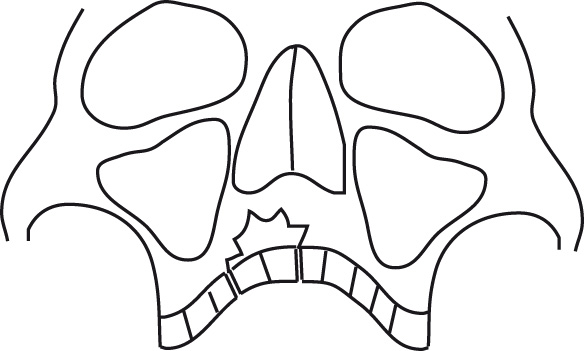
Usually occurs with other injuries such as Le Fort fracture.
Fracture patterns that occur along lines of weakness in the face. Mechanism: severe force to face as would occur in MVA. All Le Fort fractures involve the pterygoid plates of the sphenoid.
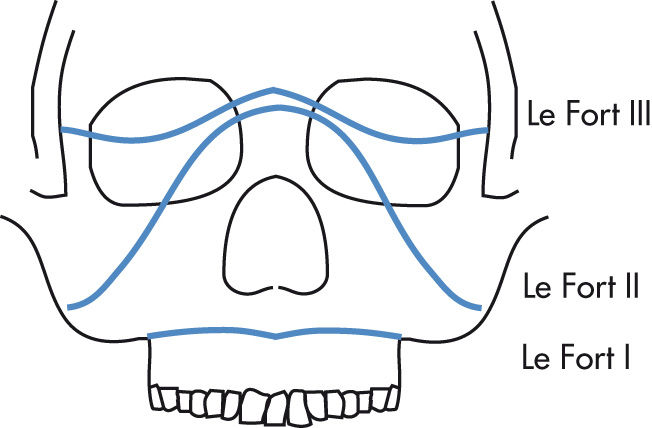
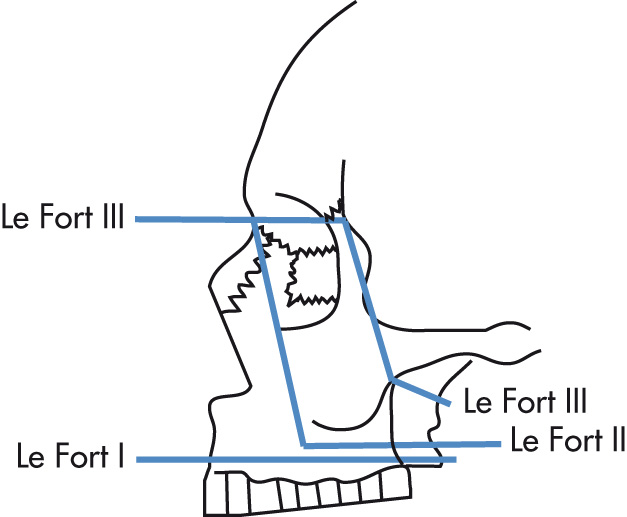
This fracture produces a floating palate; fracture lines extend through:
Nasal septum (vomer and septal cartilage)
Medial, anterior, lateral, posterior walls of maxillary sinus
Pterygoid plates of sphenoid
This fracture produces a floating maxilla; zygomatic arches are not included in this fracture; fracture line extends through:
Nasal bone and nasal septum
Frontal process of maxilla
Medial orbital wall (ethmoid, lacrimal, palatine)
Floor of orbit (inferior orbital fissure and canal)
Infraorbital rim
Anterior, lateral, posterior wall of maxillary sinus
Pterygoid plates of sphenoid
This fracture separates face from cranial vault and produces a floating face; the fracture line extends through:
Nasal bone and septum
Frontal process of maxilla
Medial wall of orbit (lacrimal, ethmoid, palatine)
Infraorbital fissure
Lateral wall of orbit
Zygomaticofrontal suture
Zygomatic arch
Pterygoid plates of sphenoid
Common in children. Medial fragment is displaced superiorly (pull from sternocleidomastoid). Lateral fragment is displaced inferior and medial (weight of arm, pull from pectoralis major). Sites of fracture include:
Lateral third: 15%
Middle third: 80%
Medial third: 5%
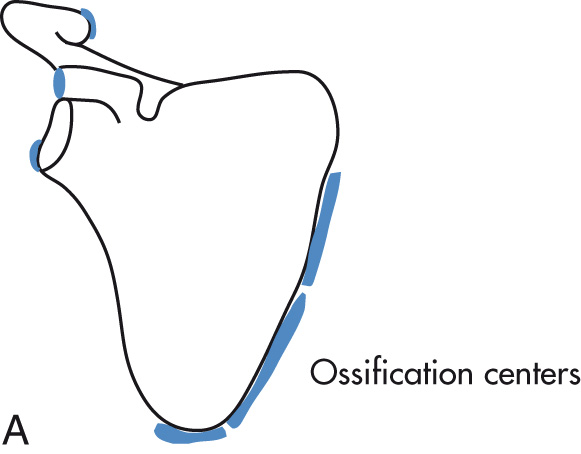
Laceration of vessels
Nerve injuries
Other associated fractures
Do not mistake rhomboid fossa (irregular concavity at the undersurface of the medial clavicle), a normal anatomic variant, for a fracture or lytic lesion.
Uncommon. Causes: MVA, fall from height (direct impact injuries). Best radiographic view: transscapular view (Y-view), CT often helpful. Do not mistake ossification centers for fractures.
Fractures usually occur in lower 10 ribs.
First and second rib fractures can occur after high energy trauma to chest and may be associated with severe mediastinal and vascular injury.
Flail chest occurs when three or more ribs fracture and each rib fractures in two places (segmental fractures). Commonly associated with pulmonary contusion, laceration, pneumothorax, hemothorax, etc.
The glenoid labrum is a fibrocartilaginous structure that attaches to the glenoid rim and is about 4 mm wide. Anteriorly, the glenoid labrum blends with the anterior band of the inferior glenohumeral ligament. Superiorly, it blends with the biceps tendon and the superior glenohumeral ligament. It is usually rounded or triangular on cross-sectional images.
The tendon of the long head of the biceps muscle attaches to the anterosuperior aspect of the glenoid rim. From its site of attachment, the biceps tendon courses laterally and exits the glenohumeral joint through the intertubercular groove where it is secured by the transverse ligament. In Fig. 5.38 the biceps tendon attaches at the level of the superior labrum and glenoid. Note attachments to the (1) superior glenoid rim, (2) the posterior labrum, (3) the anterior labrum, and (4) the base of the coracoid process.
The labral-bicipital complex is well visualized on transverse CT or MR arthrograms, as well as on coronal MR arthrograms and reconstructed images from coronal CT arthrograms.
The glenohumeral ligaments play a role as shoulder stabilizers and consist of thickened bands of the joint capsule. The superior glenohumeral ligament is the most consistently identified capsular ligament. It can arise from the anterosuperior labrum, the attachment of the tendon of the long head of the biceps muscle, or the middle glenohumeral ligament.
The middle glenohumeral ligament varies most in size and site of attachment to the glenoid. It typically has an oblique orientation from superomedial to inferolateral. It may attach to the superior portion of the anterior glenoid but more frequently attaches medially on the glenoid neck.
The middle glenohumeral ligament may be absent or may appear thick and cord like (e.g., Buford complex).
The inferior glenohumeral ligament is an important stabilizer of the anterior shoulder joint and consists of the axillary pouch and anterior and posterior bands. The anterior band inserts along the inferior two-thirds of the anterior glenoid labrum.
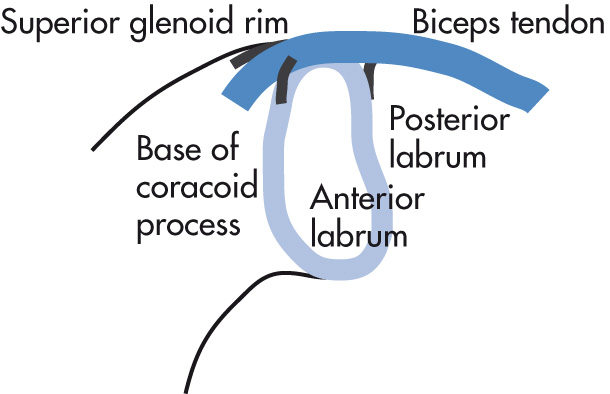
Using a high-frequency linear transducer, US can be used to examine the rotator cuff, as well as biceps tendon, AC joint, and bursae.
Normal rotator cuff is hyperechoic and fibrillary (important to insonate perpendicular to tendon plane to avoid anisotropy), is not compressible, and demonstrates an outer convex contour.
Complete tear: nonvisualization of the tendon.
Full-thickness tear: focal tendon defect/fluid; concave contour of bursal side of tendon; compressible tendon; cartilage interface sign (two parallel hyperechoic lines over humeral head)
Partial-thickness tear: bursal side or articular side flattening with hypoechoic defect or heterogeneous echogenicity.
Calcific hydroxyapatite deposits may manifest as dense or tiny calcifications with or without posterior acoustic shadowing. In calcific tendinitis, US may be used to guide fine needle aspiration and lavage.
Dislocation: separation of articular surface of glenoid fossa and humeral head that will not reduce spontaneously. Subluxation: transient incomplete separation that reduces spontaneously.
Most common type (95%) of dislocation. Usually caused by indirect force from abduction, external rotation, and extension.
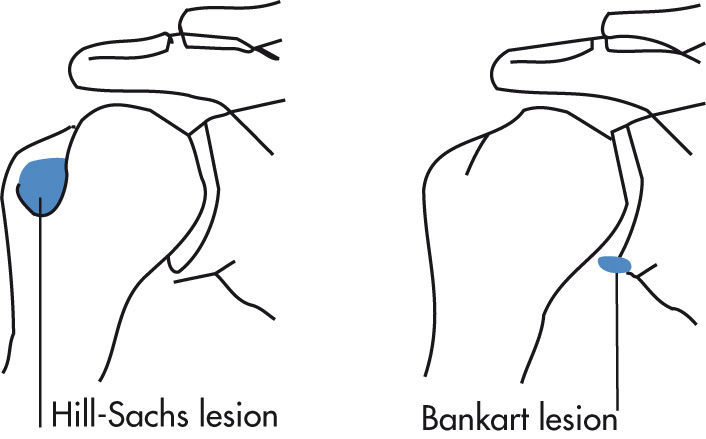
Humeral head lies inferior and medial to glenoid.
Two lesions can occur as humeral head strikes the glenoid:
Hill-Sachs lesion (posterosuperior and lateral) of humeral head (best seen on AP view with internal rotation) and bony Bankart lesion (anteroinferior) of glenoid (may require CT)
Bulbous distortion of the scapulohumeral arch (Moloney arch)
Tear of the inferior glenohumeral ligament (IGHL) from its humeral attachment = humeral avulsion of the glenohumeral ligament (HAGL) lesion
Associated labral tears ( Fig. 5.40 ):
Abduction and external rotation (ABER) view: stretches the IGHL, improves detection of anterior-inferior labral tears.
Bankart lesion: complete detachment of anterior inferior labrum and often IGHL or middle glenohumeral ligament (MGHL)
Perthes lesion: labral tear with periosteal stripping, labrum remains attached to periosteum
Anterior labral periosteal sleeve avulsion (ALPSA): basically a medially displaced Perthes lesion, labrum remains attached to periosteum
Glenolabral articular disruption (GLAD), superficial labral tear with glenoid cartilage injury. In contrast to the above labral tears, it is not associated with shoulder instability.
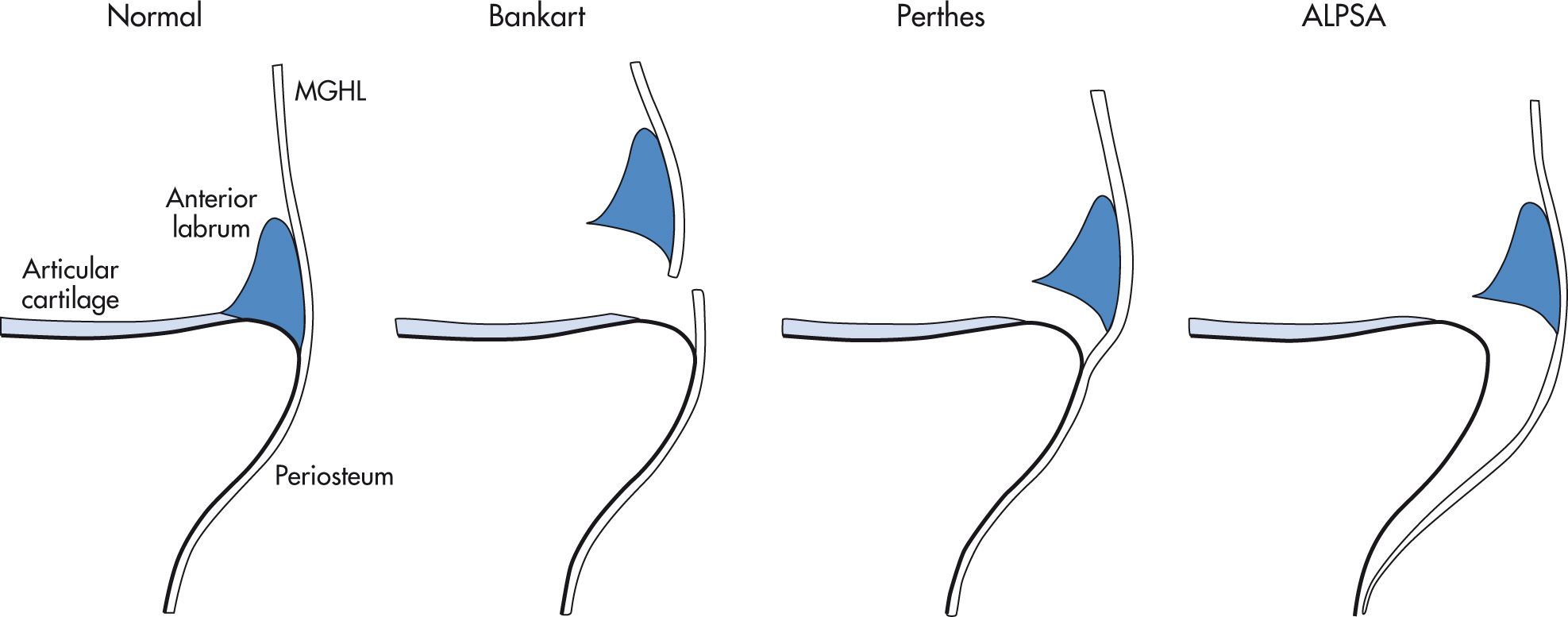
Less common (5%); usually caused by direct or indirect force (fall on flexed and abducted arm). Associated with seizures or electrical shock (bilateral).
Lightbulb sign: appearance of the internally rotated humeral head on AP radiograph
Bennett lesion: rim of calcification along posterior glenoid, associated with posterior capsule avulsive injury (baseball pitchers or other overhead throwing athletes)
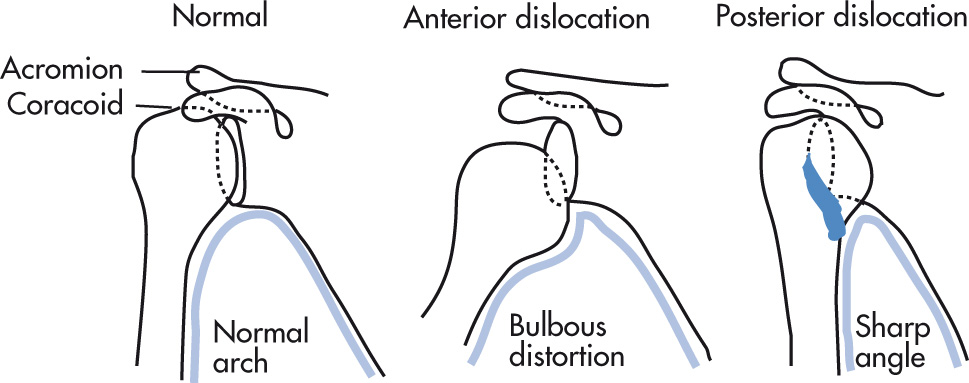
Humeral head lies superior to glenoid.
Trough sign: compression fracture of the anterior humeral surface, 15% (best seen on AP view with external rotation or axillary view)
Sharp angle of the scapulohumeral arch (Moloney arch)
Posterior displacement is best seen on axillary view.
40-degree posterior oblique (Grashey view) may be needed: loss of glenohumeral space is diagnostic.
Fixed in internal rotation
Also called luxatio erecta: the humeral head is located below the glenoid and the shaft of the humerus is fixed in extreme abduction. Complications of luxatio erecta include injuries to the brachial plexus and axillary artery.
Inferior and lateral displacement of humeral head because of hemarthrosis that often occurs in fractures of humeral head or neck. Not a true inferior dislocation.
The rotator cuff (inserts into anatomic neck and tuberosities of humerus) consists of four muscles. Mnemonic: SITS :
S upraspinatus
I nfraspinatus
T eres minor
S ubscapularis
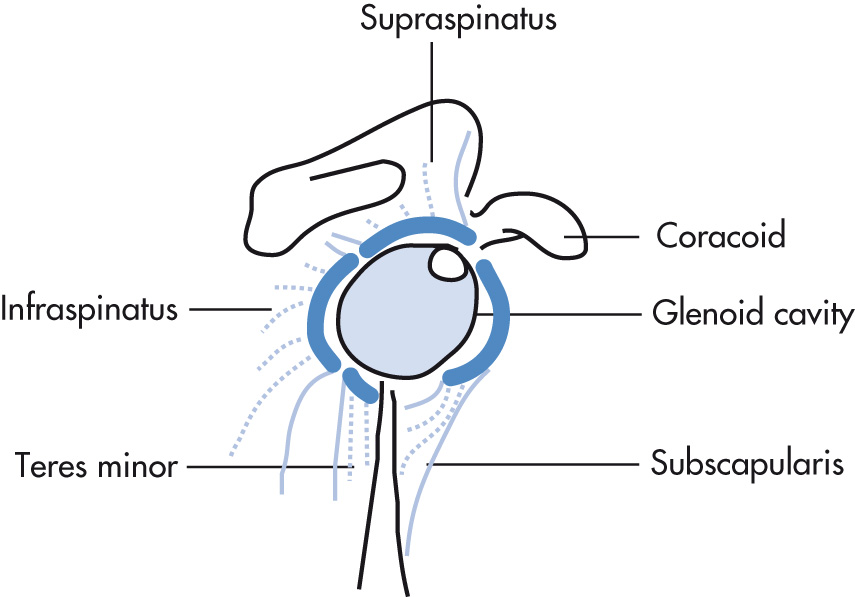
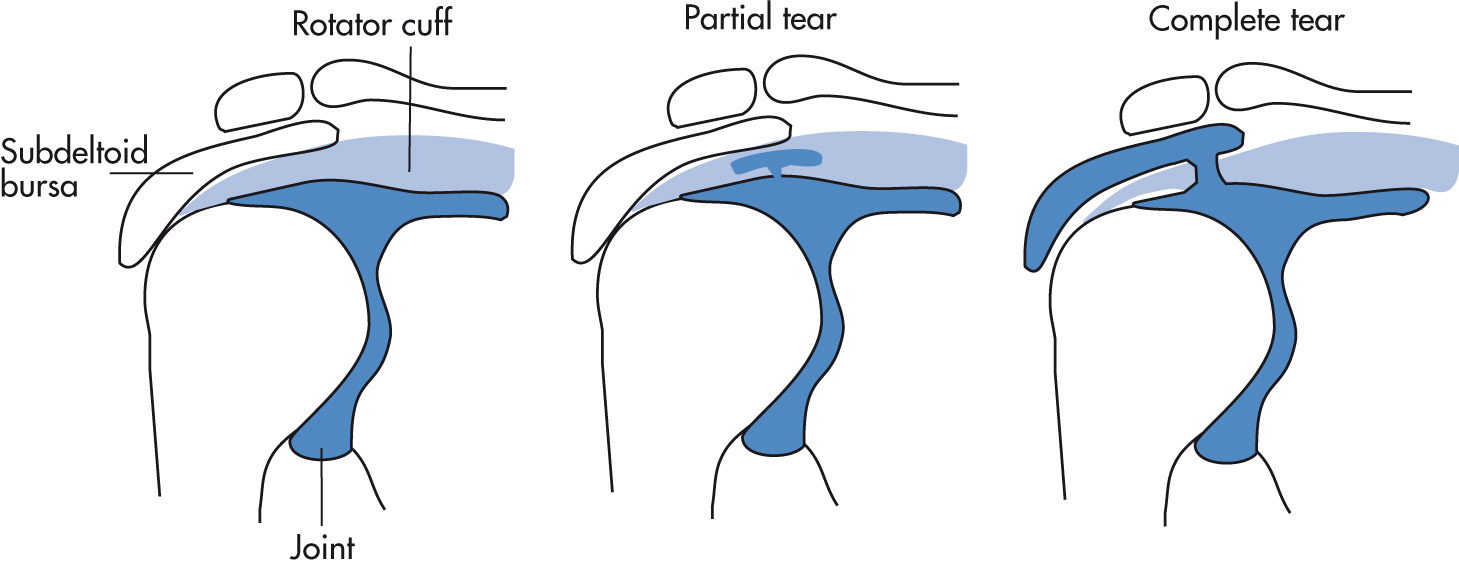
Degeneration
Trauma
Impingement
Narrowing of acromiohumeral space to <6 mm (chronic rupture)
Eroded inferior aspect of acromion (chronic rupture)
Flattening and atrophy of the greater tuberosity of the humeral head (chronic rupture)
Acromial undersurface contour, Bigliani classification (assessed on sagittal oblique MR, type 3 strongly associated with rotator cuff impingement) ( Fig. 5.44 ):
Type 1: flat
Type 2: concave, without subacromial space narrowing
Type 3: acute inferior downslope (hooked) with narrowing.
Type 4: convex
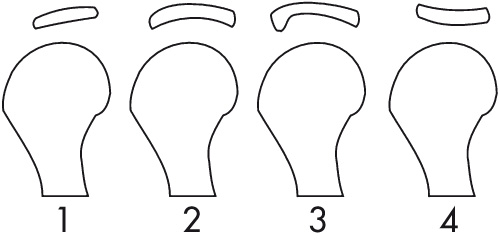
Arthrogram
Opacification of subacromial-subdeltoid bursa
Contrast may leak into the cuff in partial tears
MRI features:
MR arthrography is most accurate diagnostic study
MR can distinguish full thickness (perforating tear, part of the tendon is intact) from complete (complete tendon interruption) tears.
Full-thickness tears are often associated with fluid in the subacromial/subdeltoid bursa.
Partial-thickness tears may be articular surface, bursal surface, or intrasubstance tears.
High-grade partial thickness tears >50%
Tendon retraction should be reported because retraction >3–4 cm reduces potential for surgical repair.
Fatty atrophy of a rotator cuff muscle indicates chronic tear.
Medial dislocation/subluxation of the biceps from the intertubercular groove indicates subscapularis tear
Normal labral variants:
Sublabral foramen between one and three o'clock
Buford complex: absent labrum from one to three o'clock, with thickened medial glenohumeral ligament
Sublabral sulcus in superior labrum
Anterior-to-posterior lesions of the superior labrum (superior labral tear from anterior to posterior [SLAP] lesions)
SLAP tears are usually oriented from superior-lateral to inferior-medial
Type I: fraying or tear of the superior labrum
Type II: detachment of the labral-bicipital complex from the superior glenoid
Type III: bucket-handle tear of the superior labrum
Type IV: bucket-handle tear with extension into the biceps tendon
Supraspinatus/infraspinatus: suprascapular nerve impingement in the suprascapular notch (e.g., by a paralabral cyst caused by a labral tear)
Parsonage-Turner syndrome: acute brachial neuritis. Early edema and thickening of supraspinatus and infraspinatus; later, atrophy
Infraspinatus: suprascapular nerve impingement after branch to supraspinatus in the spinoglenoid notch
Teres minor (quadrilateral space syndrome): axillary nerve impingement in the quadrilateral space (bounded by teres minor superiorly, teres major inferiorly, humerus laterally, long head of triceps medially) secondary to fibrous band, fracture, mass lesion, etc.
Pain, stiffness, and limited range of motion from posttraumatic adhesive inflammation of the joint capsule.
Decreased size of joint capsule
Obliteration of axillary and subscapular recesses
Disuse osteoporosis
Arthrogram if persistent
Most commonly results from athletic injury to AC joint
Direct blow to AC joint (e.g., football)
Severe arm traction
Fall on hand or elbow with arm flexed 90 degrees
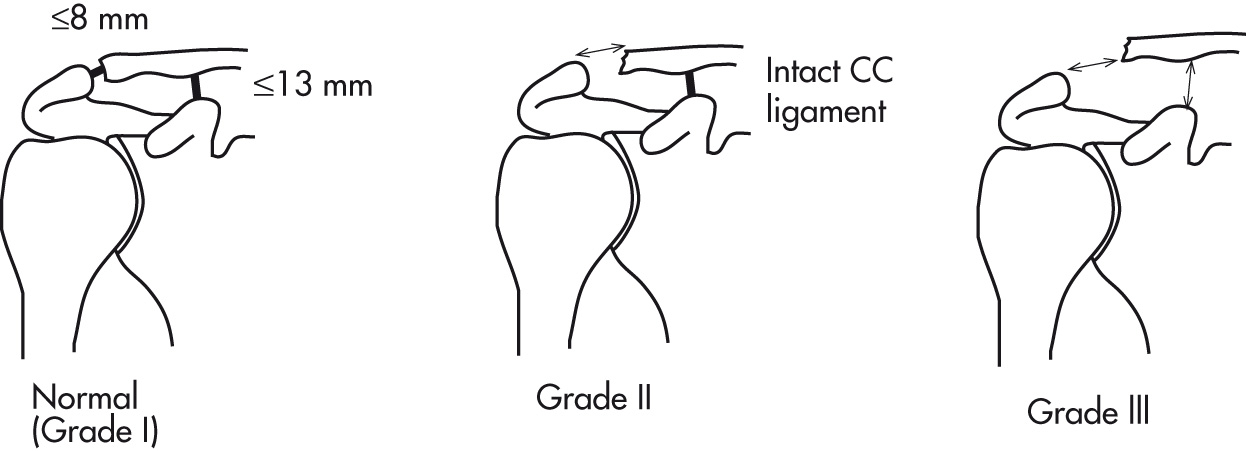
Technique
AP view with 15 degree cephalad angulation is the preferred view for diagnosis.
May need opposite shoulder for comparison
May need stress views (2- to 10-kg weights)
Normal
AC distance ≤8 mm
Coracoclavicular distance ≤13 mm
Inferior margin of clavicle lines up with inferior acromion.
AC joint injury
Downward displacement of scapula/extremity
Downward displacement and AC separation worsen with stress weights.
AC widening = disrupted AC ligament
Craniocaudad (CC) widening because of disrupted AC ligament
Six grade classifications (Rockwood):
Grade I (mild sprain): normal radiograph
Grade II (moderate sprain): increased AC distance; normal CC distance
Grade III (severe sprain): increased AC and CC distance
Grade IV: total dislocation; clavicle displaced superoposteriorly into the trapezius
Grade V: total dislocation; clavicle displaced superiorly into neck
Grade VI: total dislocation; clavicle displaced interiorly to subacromial or subcoracoid position
Most injuries of the sternoclavicular joint are dislocations resulting from a direct forceful impact. Although anterior dislocations are more common, posterior dislocations are more serious because the great vessels or trachea may be injured.
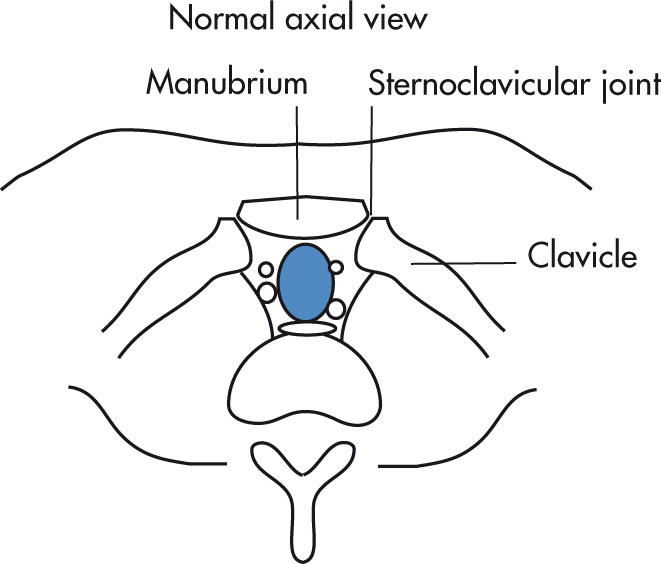
Superior displacement of clavicle
Many injuries occur as Salter fractures of medial clavicular epiphysis.
CT is the examination of choice: thin section with coronal reformation.
Angled AP plain radiograph (serendipity view) is not as helpful.
These fractures are common in osteoporotic older adult patients secondary to a fall on outstretched hand. 85% are nondisplaced; 4-segment Neer classification aids in treatment and prognosis.
Based on number and type of displaced segments. 4 segments: anatomic neck, surgical neck, greater tuberosity, lesser tuberosity. Displacement defined as (1) >1 cm separation of fragments or (2) >45-degree angulation.
1-part: no displacement (regardless of comminution); treated with sling
2-part: displacement of 1 segment; closed reduction
3-part: displacement of 2 segments, 1 tuberosity remains in continuity with the head; closed reduction
4-part: displacement of 3 segments; open reduction and internal fixation or humeral head replacement
2-, 3-, and 4-part fractures may have anterior or posterior dislocation.
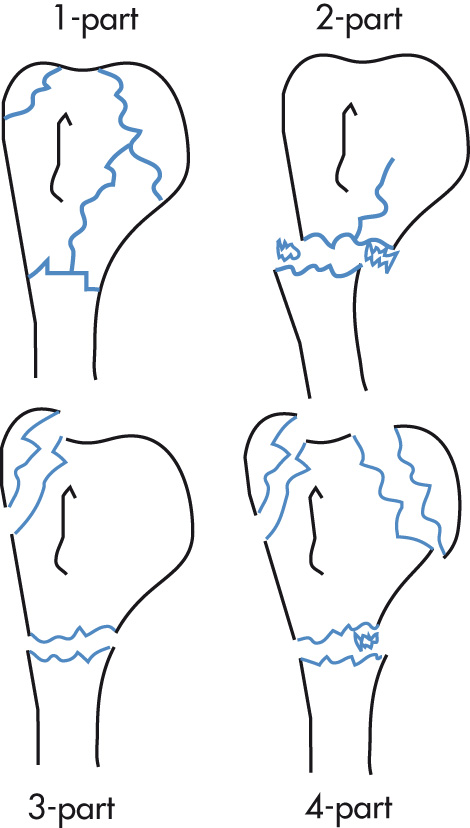
Fracture lines according to Neer classification
Pseudosubluxation: inferior displacement of humeral head because of hemarthrosis
Subacromial fat-fluid level: lipohemarthrosis
Transthoracic or transscapular views useful to accurately determine angulation
Supracondylar-extraarticular fracture (three types)
Type I: nondisplaced
Type II: displaced with posterior cortical continuity
Type III: totally displaced
Transcondylar-intraarticular fracture
Intercondylar (bicondylar)-intraarticular fracture (four types)
Type I: nondisplaced
Type II: displaced
Type III: displaced and rotated
Type IV: displaced and rotated and comminuted
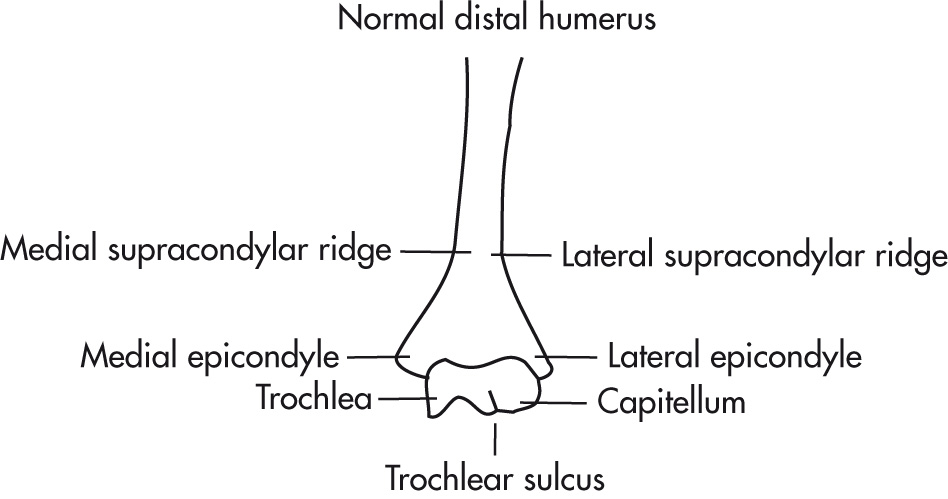
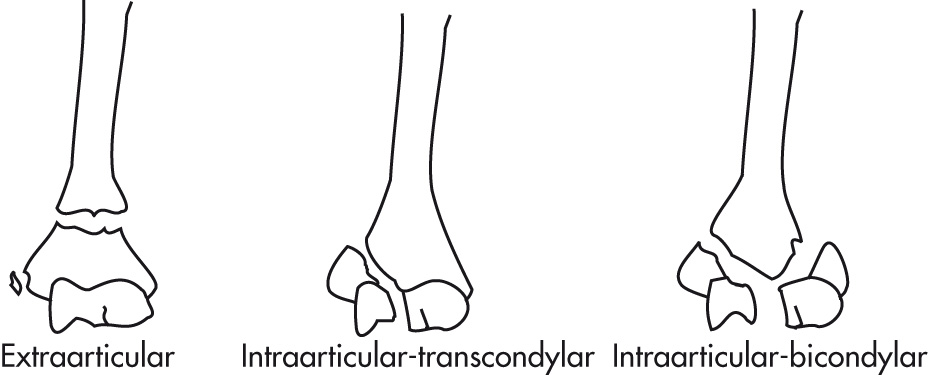
Volkmann ischemic contracture (usually secondary to supracondylar fracture)
Malunion (results in “cubitus varus” deformity)
Common fracture that results from a fall on outstretched hand.
No displacement: splint, cast
>3-mm displacement on lateral view: open reduction and internal fixation (ORIF)
Comminuted: excision of radial head
Positive fat pad sign
Anterior fat pad has the appearance of a sail (sail sign).
A positive posterior fat pad is a good indicator of a fracture that is not normally seen.
Fracture line may be difficult to see on standard projections. If in doubt, obtain radial head view, oblique views, or tomograms.
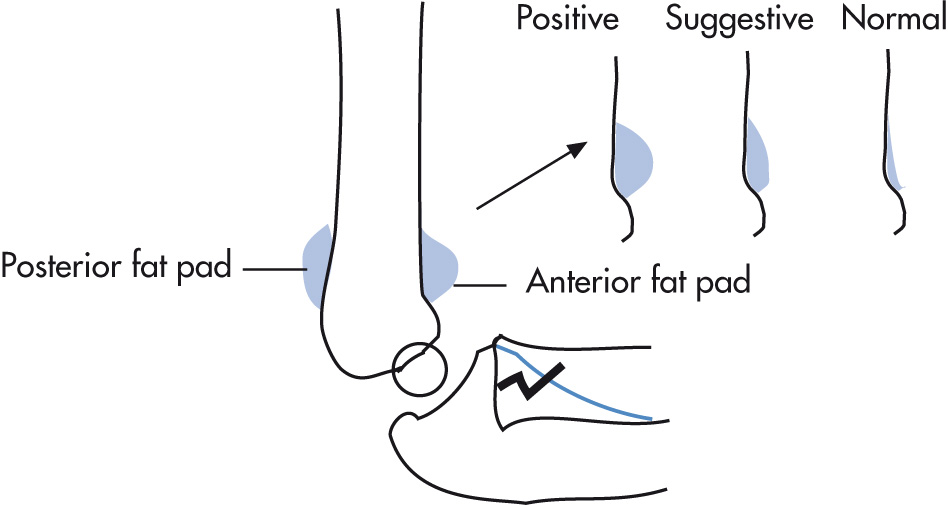
Isolated ulnar fractures are uncommon. Most fractures of the ulna also involve the radius (see below).
Result from direct fall on flexed elbow. Treated conservatively if nondisplaced. ORIF if displaced (by pull of triceps). Best view: lateral.
Usually in association with posterior elbow dislocations. Best view: radial head or oblique views.
Different types of dislocations are defined by the relation of radius/ulna to distal humerus. Posterior dislocations of both the radius and ulna are the most common type (90%). Often associated with coronoid process or radial head fractures. Complication: myositis ossificans. Three types include:
Ulna and radius dislocation (most common)
Ulna dislocation only
Radial dislocation only (rare in adults)
Most (60%) forearm fractures involve both the radius and ulna.
Ulnar shaft fracture and radial head dislocation
Distal radial shaft fracture and distal radioulnar dislocation
Comminuted radial head fracture and distal radioulnar subluxation/dislocation
Mechanism of injury: fall on the outstretched hand with the forearm pronated in dorsiflexion. Most common injury to distal forearm, especially in osteoporotic females.
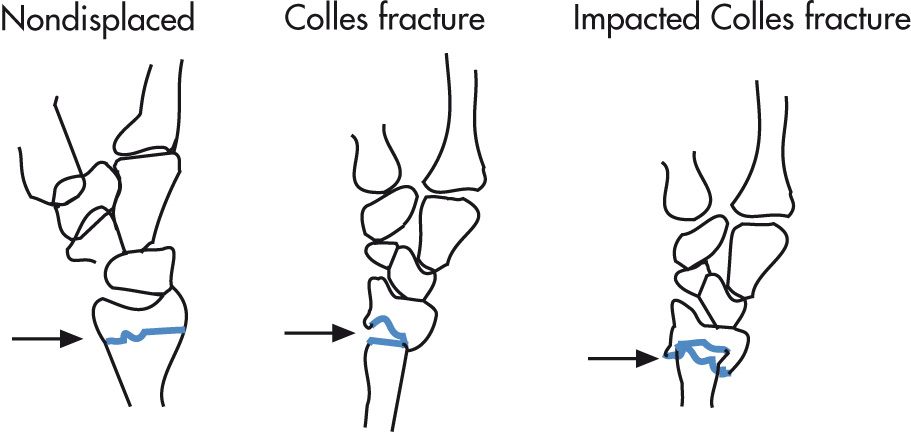
Extraarticular fracture (in contradistinction to Barton fracture)
Distal radius is dorsally displaced/angulated.
Ulnar styloid fracture, 50%
Foreshortening of radius
Impaction
Median, ulnar nerve injury
Posttraumatic radiocarpal arthritis
Intraarticular fracture of the dorsal margin of the distal radius. The carpus usually follows the distal fragment. Unstable fracture requiring ORIF and/or external fixation.
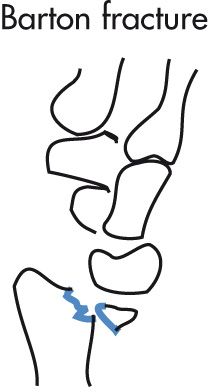
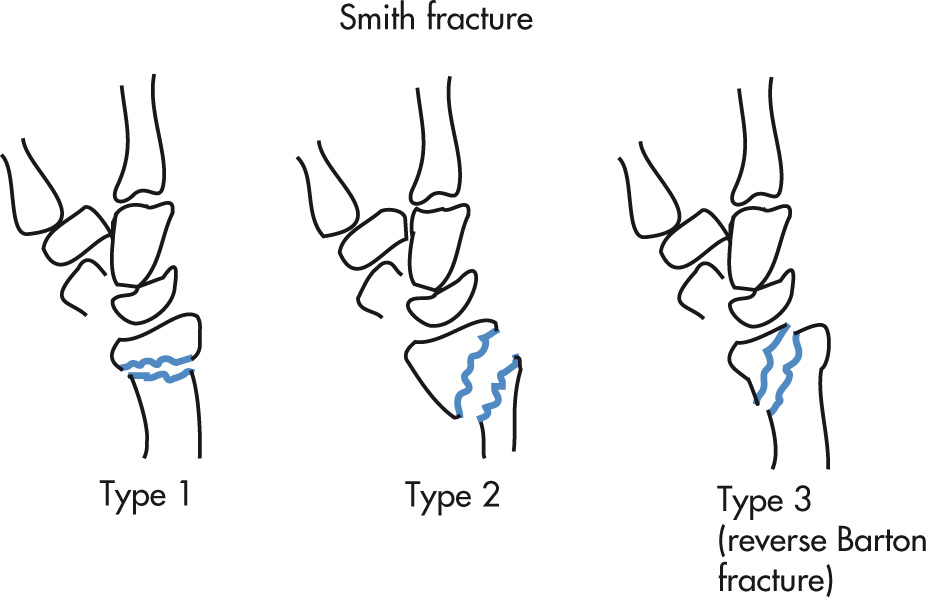
Same as a Colles fracture except there is volar displacement and angulation of the distal fragment
Three types
Type 1: horizontal fracture line
Type 2: oblique fracture line
Type 3: intraarticular oblique fracture = reverse Barton fracture
Intraarticular fracture of the volar aspect of the articular surface.
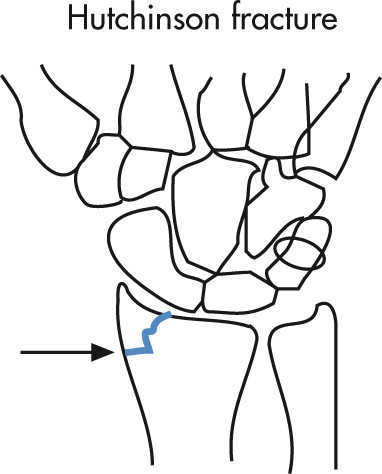
Fracture of the styloid process. Either by direct blow to back of wrist (hand crank of old cars started by hand) or forced dorsiflexion and abduction. Often associated with scapholunate disassociation and ulnar styloid process fracture.
Most commonly because of ligamentous injury of the proximal carpal row (trauma or arthritis). Best diagnosed by stress fluoroscopy and/or plain radiograph evaluation of the scapholunate and capitolunate relationships.
Ulnar collateral ligament (UCL)
Three components: anterior (most important), posterior, and transverse bands
UCL tear = baseball pitcher injury. Anterior band attaches to sublime tubercle of medial epicondyle and lies deep to common flexor tendon of elbow. Posterior band attaches to lateral aspect of ulna at supinator crest. MRI: T1 globular signal, increased T2 signal.
Radial collateral ligament complex
Four components: annular (torn with elbow dislocation), radial collateral, lateral ulnar collateral ligament (LUCL, most important), and accessory collateral ligaments
Common extensor tendon originates from lateral epicondyle (repetitive varus stress leads to lateral epicondylitis or tennis elbow, often associated with LUCL injury)
Common flexor tendon originates from medial epicondyle (repetitive valgus stress leads to medial epicondylitis or golfer's elbow)
Avascular necrosis (AVN) of capitellum: Panner disease, occurs in boys 7–12 years of age before complete capitellar ossification.
Osteochondral defect (OCD) of capitellum: caused by repetitive valgus stress in young competitive athletes (12–16 years), most often involves anterior capitellum (do not mistake for normal “pseudodefect” that is caused by sharp angulation of posterior capitellum)
Ulnar nerve in cubital tunnel most commonly affected
Cubital tunnel floor = posterior and transverse bands of UCL
Roof = arcuate ligament. Replaced with anconeus epitrochlearis muscle in 10%–20%, which causes ulnar nerve compression. Cubital tunnel narrows during elbow flexion, ulnar nerve compression common in overhead-throwing athletes.
Radial nerve: injured by humeral shaft fracture. Other causes: supinator syndrome.
Median nerve
Avian (supracondylar) spur ( Fig. 5.55 ): present in 1%, located at anteromedial humerus around 5 cm from medial epicondyle
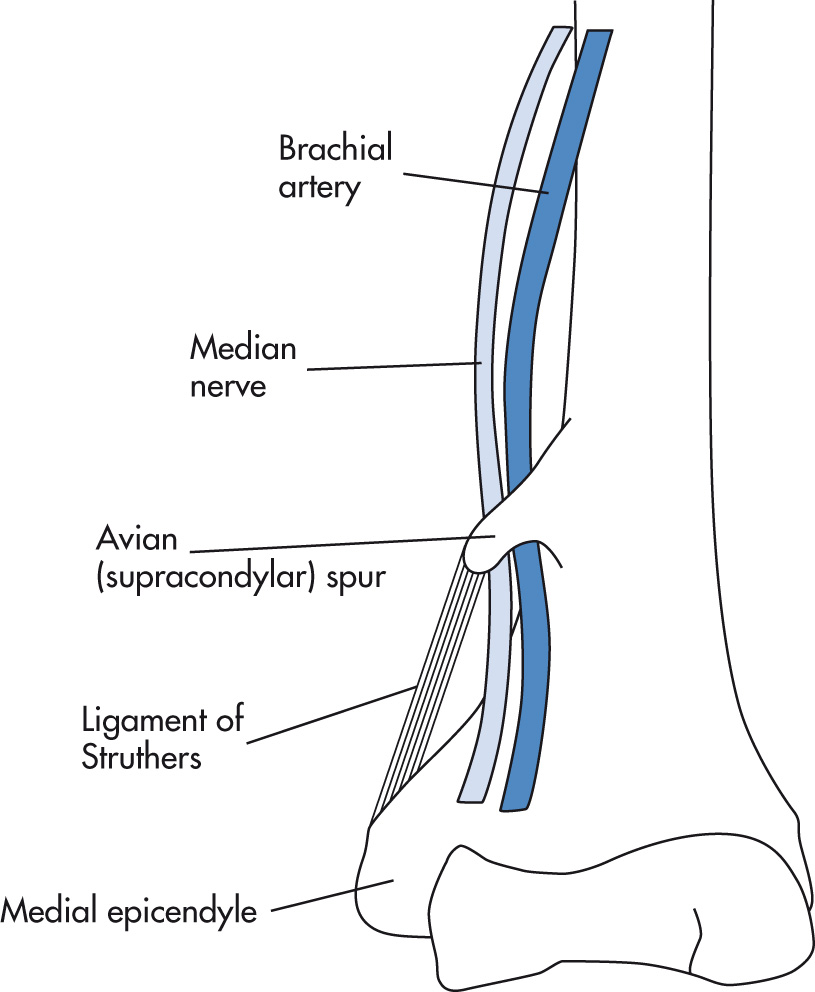
Ligament of Struthers (present in 3%) connects avian spur to medial epicondyle forming supracondylar canal, which contains median nerve and brachial artery.
Pronator syndrome: compression between superficial and deep heads of pronator teres muscle.
Lunate
Scaphoid
Trapezium
Trapezoid
Capitate
Hamate
Triquetrum
Pisiform
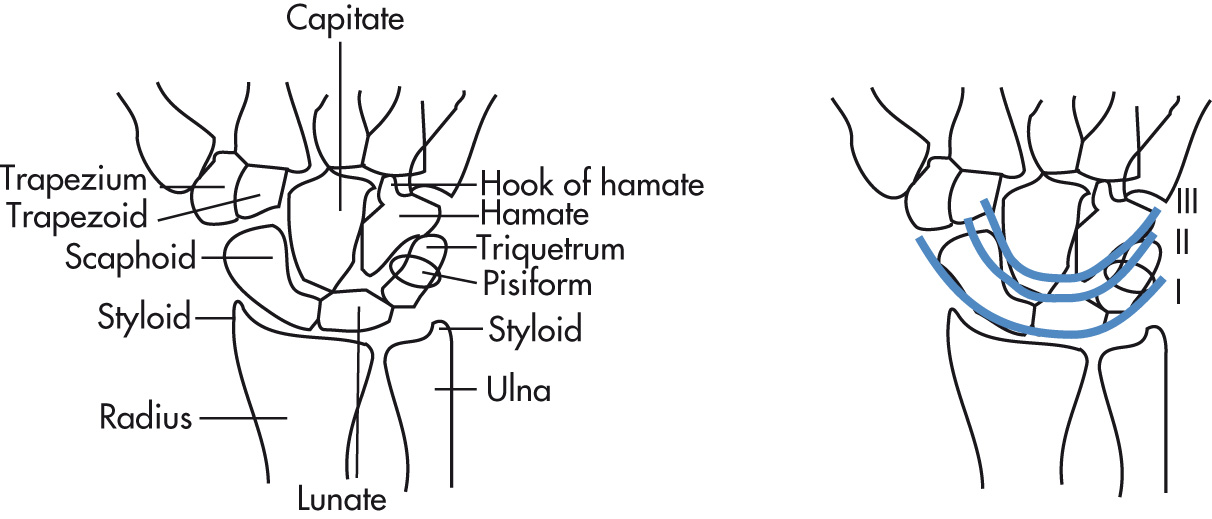
Neutral ulnar variance (normal) 80% load by radius, 20% by ulna
Negative ulnar variance (abnormal). Associated with Kienböck disease
Positive ulnar variance (abnormal). Associated with:
Scapholunate instability
Ulnar impaction syndrome
Triangular fibrocartilage tear
Previous radial head excision
Aging
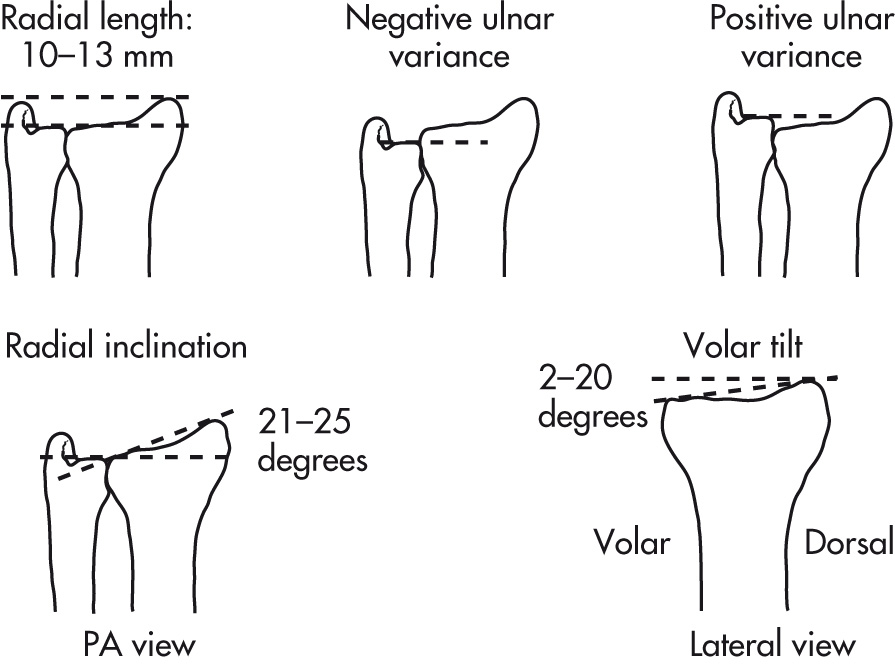
Standard radiographic assessment to quantify deformities associated with distal radius fractures should also consist of three radiographic measurements, which correlate with patient outcome:
Radial length (radial height): on posteroanterior (PA) view, distance between line perpendicular to the long axis of the radius passing through the distal tip of the sigmoid notch at the distal ulnar articular surface of the radius and a second line at the distal tip of the radial styloid. This measurement is normally 10–13 mm. A shortening of >3 mm is usually symptomatic and leads to positive ulnar variance.
Radial inclination (radial angle): on PA view, angle between line connecting the radial styloid tip and the ulnar aspect of the distal radius and a second line perpendicular to the longitudinal axis of the radius. The normal radial inclination ranges between 21 and 25 degrees. Loss of radial inclination increases load across the lunate.
Volar tilt of the distal radius (palmar tilt): on lateral view, the angle between a line along the distal radial articular surface and the line perpendicular to the longitudinal axis of the radius at the joint margin. The normal volar tilt averages 11 degrees and has a range of 2 to 20 degrees. Dorsal intercalated segment instability (DISI) (see later) may result from an angle >25 degrees.
Most common fracture of carpus. Mechanism: fall on outstretched hand in young adults. Locations:
Waist, 70%
Proximal pole, 20%
Distal pole, 10%
Blood supply to the proximal pole enters at the waist; therefore the proximal pole is at high risk for nonunion and osteonecrosis.
Fracture may be difficult to detect on plain radiograph.
Scaphoid views (PA view in ulnar deviation) may be useful to demonstrate fracture.
Loss of navicular fat stripe on PA view.
If a fracture is clinically suspected but not radiographically detected, use multidetector CT. In the absence of multidetector CT and high-quality reformations, thin-section CT may be performed along the coronal and sagittal axes of the scaphoid:
Coronal position is obtained by placing the patient prone, with elbow flexed 90 degrees and hand placed ulnar side down above the patient's head; images are acquired parallel to the dorsum of the wrist. Alternatively, with the palm side down, the hand and wrist are elevated 30–45 degrees and images acquired parallel to the dorsal aspect of the scaphoid.
Long sagittal position can be obtained by placing wrist palm down with hand, wrist, and forearm at 45-degree angle to the long axis of the CT table. Anatomically, this alignment can be recognized by identifying the base of the thumb and the hard bone prominence on the middle portion of the distal radius (Lister tubercle).
Bone scan: highly sensitive; increased uptake may represent fracture, and decreased uptake proximally may represent possible AVN. Does not offer anatomic detail or distinguish marrow edema/bone bruise from fracture.
MRI: highly sensitive to fractures and allows imaging of planes along the long and short axes of the scaphoid
Cast and repeat plain radiographs in 1 week.
Waist fracture: 90% heal eventually; 10% nonunion or proximal AVN
Proximal fracture: high incidence of nonunion or AVN
Distal fracture: usually heals without complications
Dorsal avulsion at attachment of radiocarpal ligament (most common type of fracture)
Best seen on lateral view
Hook of hamate fracture: diagnosis requires tomography, carpal tunnel view, or CT
Other fractures are usually part of complex fracture-dislocations.
Kienböck disease (lunatomalacia)
AVN of lunate secondary to (usually trivial) trauma
Associated with ulnar minus variant
Acute lunate fractures are rare.
Stahl classification (radiographs):
Stage 1: normal radiograph
Stage 2: increased lunar radiodensity
Stage 3: lunate collapse
Stage 4: degenerative changes around lunate
Preiser disease (scaphomalacia)
AVN of scaphoid secondary to (usually trivial) trauma without fracture, or drugs (e.g., steroids)
Type 1: complete, indicates poor outcome.
Type 2: partial, associated with better outcome.
Greater arc injury
Greater arc injuries extend through radial styloid and scaphoid across hamate, capitate, triquetrum, and ulnar styloid.
The continuum of perilunate injuries ranges from disassociation to dislocation. Mechanism: backward fall on extended hand. Each of the four successive stages progresses from radial to ulnar side with ligamentous injury around the lunate, and indicates increased carpal instability.
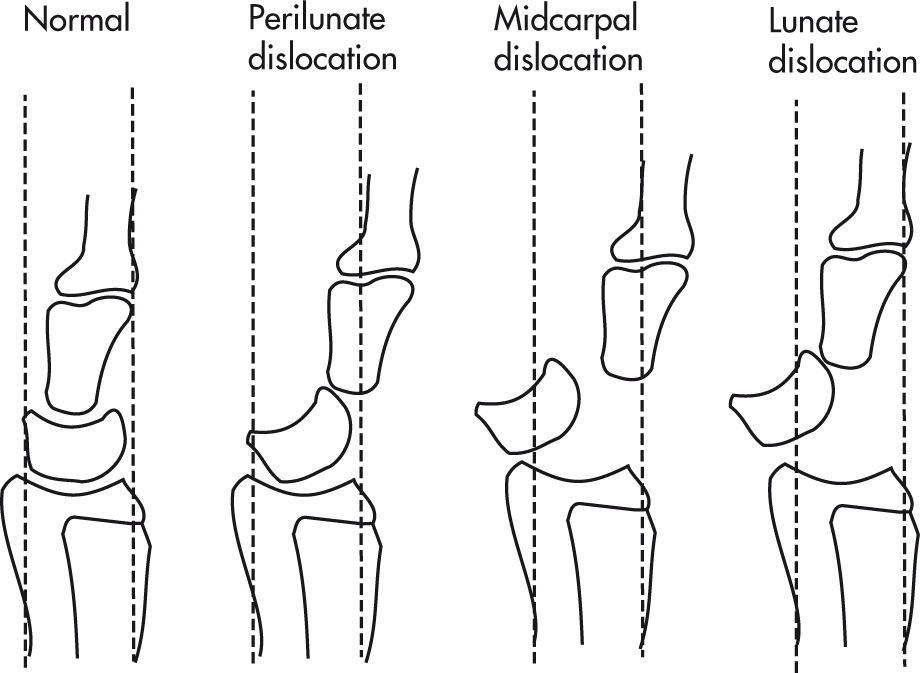
Rupture of scapholunate ligaments
>3-mm gap between lunate and scaphoid (Terry-Thomas sign)
Ring sign on PA view secondary to rotary subluxation of scaphoid
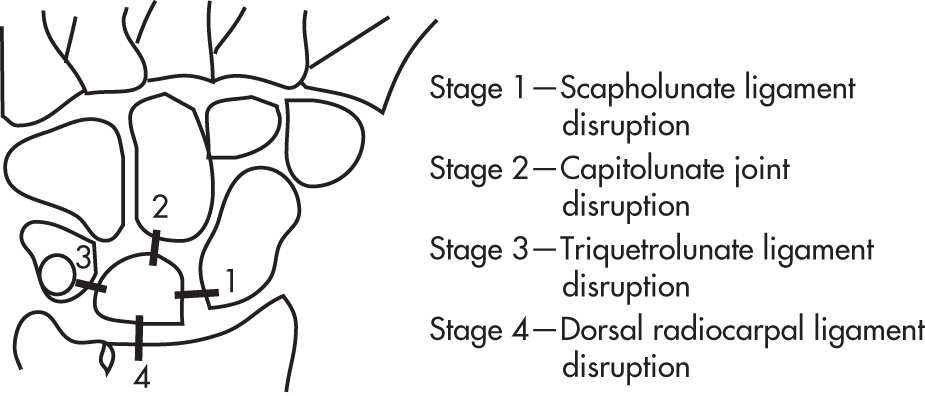
Capitate dislocated dorsally, while the lunate maintains normal articulation with radius.
Disruption of the capitolunate joint (often the radiocapitate ligament)
May be accompanied by transscaphoid fracture, triquetrum fracture, capitate fracture, and radial styloid process fracture
Rupture of triquetrolunate ligament (or triquetrum fracture)
Capitate and carpus are dislocated dorsally.
Lunate dislocates volarly.
Disruption of the dorsal radiolunate ligament.
Capitate appears aligned with the radius.
Most commonly caused by ligamentous injury of the proximal carpal row (trauma or arthritis). Best diagnosed by stress fluoroscopy and/or plain radiograph evaluation of the scapholunate and capitolunate relationships.
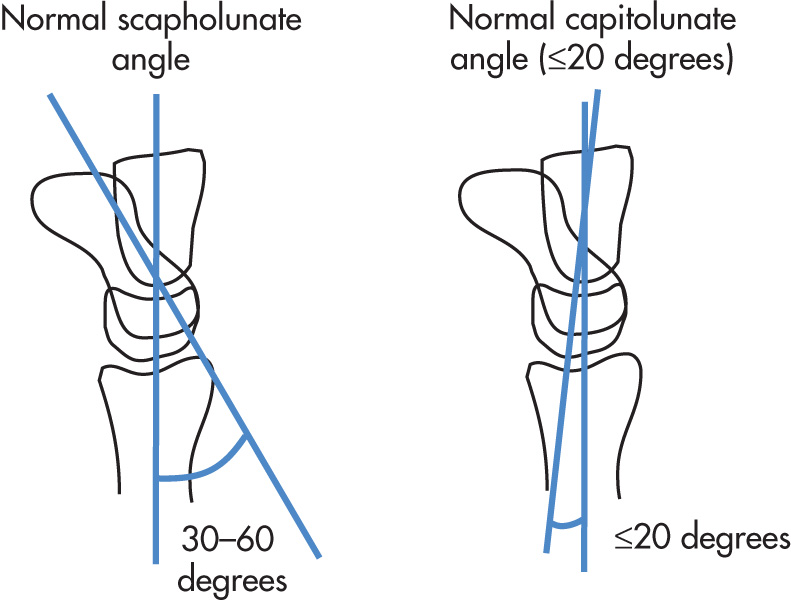
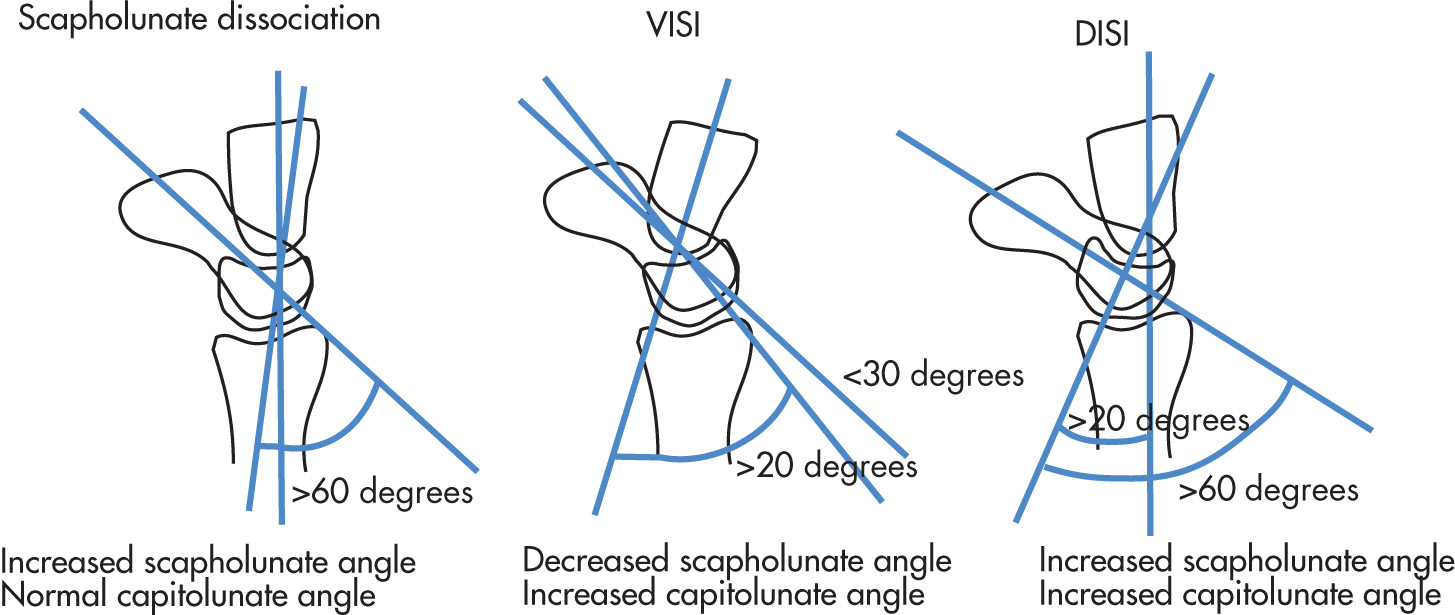
Scapholunate angle >60 degrees
Increased capitolunate angle
Volar tilt of lunate
Scapholunate angle sometimes decreased
Much less common than DISI
Increased scapholunate and capitolunate angles
Dorsal tilt of lunate
Specific pattern of OA associated with chronic scapholunate dissociation and chronic scaphoid nonunion. Calcium pyrophosphate dihydrate (CPPD) is the most common cause.
Radial-scaphoid joint is initially involved, followed by degeneration in the unstable lunatocapitate joint as capitate subluxates dorsally on lunate.
Radioscaphoid joint is first to be involved; capitolunate and scaphotrapeziotrapezoid (STT) joints follow.
Capitate migrates proximally into space created by scapholunate dissociation.
Radiolunate joint is spared.
In end-stage SLAC, the midcarpal joint collapses under compression, and the lunate assumes an extended or dorsiflexed position DISI.
Multidetector CT has revolutionized evaluation of the wrist. Special patient positions are no longer necessary because high-quality reformatted images can be obtained along any plane from a multidetector CT dataset. However, for historical purposes, dedicated CT of the distal radius, ulna, and carpus can also be performed in several planes.
CT in the transverse plane has been used to evaluate the distal radioulnar joint and the carpal bones or to further assess a longitudinal fracture. The coronal plane provides an image similar to the standard PA radiograph but will provide better soft tissue and bone detail than will a routine radiograph.
Coronal CT also demonstrates the radiocarpal joint well.
In general, 2-mm thick sections at 2-mm intervals will be satisfactory to show the anatomic detail of distal radius and ulnar fractures along articular surfaces. When evaluating carpal bone fractures and displacements, it is sometimes of value to add 2-mm thick sections at 1-mm intervals in one plane for more anatomic detail, as for a scaphoid fracture.
Fernandez and Jupiter, or mechanistic, classification system for distal radial fractures. This classification system closely mirrors prognosis. Fracture forces and comminution progressively increase from type I to type V:
Type I: bending fractures; include metaphyseal Colles and Smith fractures. These are caused by tensile volar or dorsal loading, respectively, with subsequent comminution of the opposite cortex.
Type II: shear fractures of the joint surface; includes volar and dorsal Barton injuries.
Type III: compression fractures of the articular surface; includes die-punch fractures.
Type IV: avulsion fractures and associated with radiocarpal fracture-dislocations; includes radial and ulnar styloid injuries.
Type V: high-velocity injuries with comminution and often with bone loss; related to a complex interaction of multiple forces.
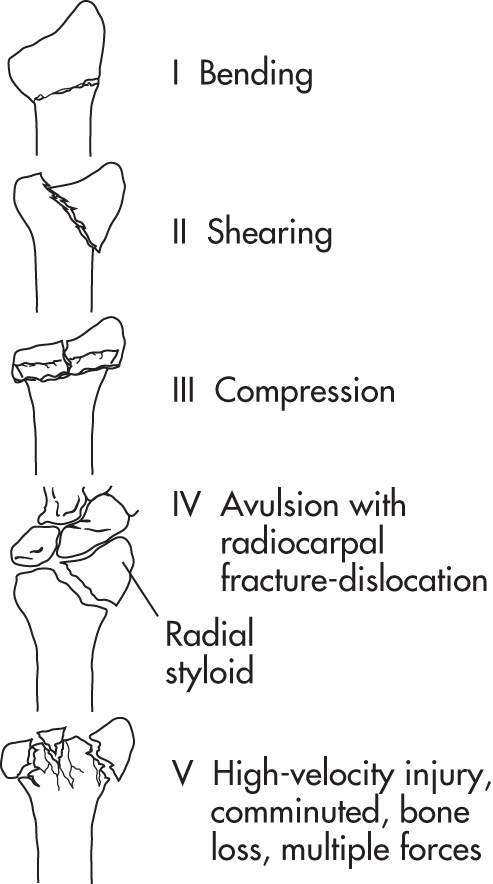
Metacarpals
Phalanges: distal, medial, proximal
Joints: distal interphalangeal (DIP), proximal interphalangeal (PIP), metacarpophalangeal (MCP)
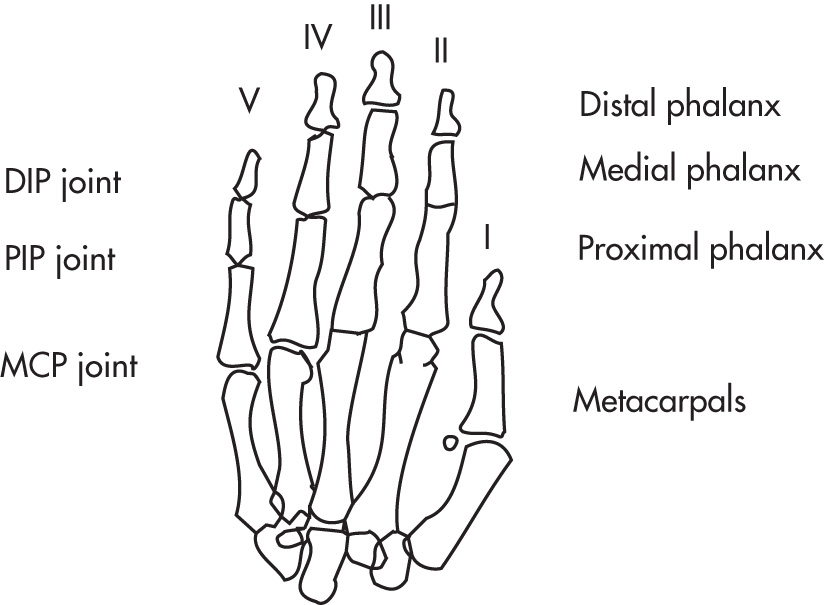
Bennett and Rolando fractures are intraarticular MCP fracture-dislocations of the thumb. These fractures must be distinguished from extraarticular fractures located distal to the carpometacarpal (CMC) joint because the former may require open reduction.
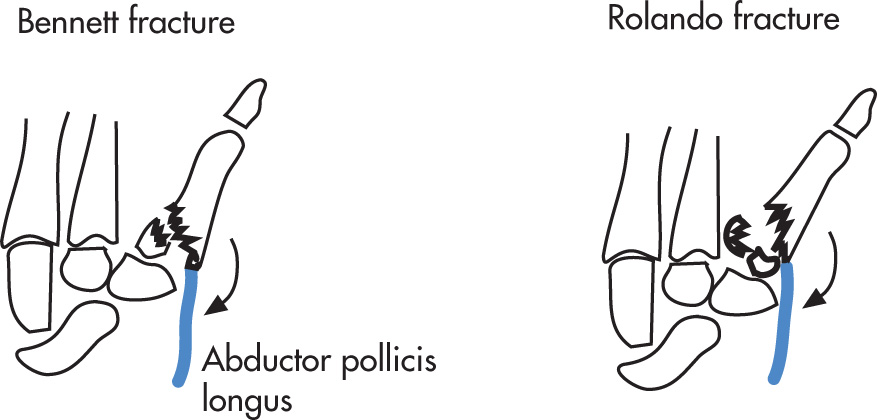
Dorsal and radial dislocation (force from abductor pollicis longus)
Small fragment maintains articulation with trapezium.
Comminuted Bennett fracture; the fracture line may have a Y, V, or T configuration.
Fracture of the MCP neck (most commonly fifth MCP) with volar angulation and often external rotation of the distal fragment. Simple fractures are reduced externally, whereas volar comminution usually requires ORIF.
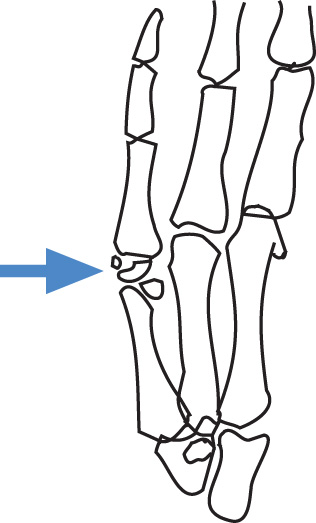
Results from disruption of UCL. Often associated with a fracture of the base of the proximal phalanx. Common injury in downhill skiing (thumb gets hung up in ski pole). Stress views are required if no fracture is identified on routine plain radiographs but is clinically suspected.
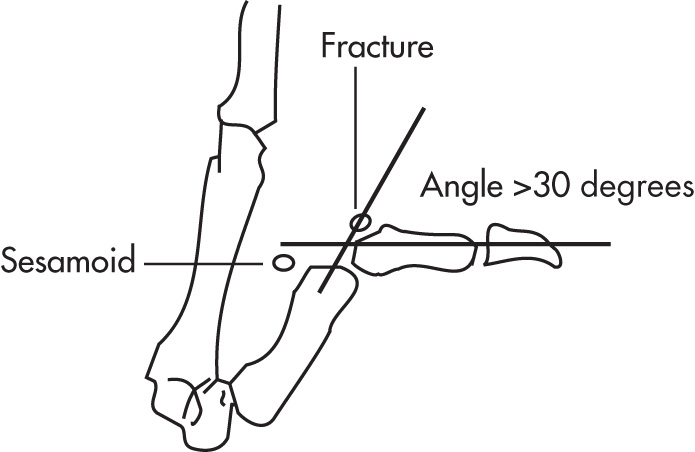
Occurs in a subset of patients with gamekeeper's thumb, when the UCL is completely torn and displaced superficial and proximal to the adductor pollicis aponeurosis, preventing the UCL from returning to its normal position. Detect with US or MR (yo-yo sign). Surgical lesion.
Results from forceful pull at tendinous and ligamentous insertions.
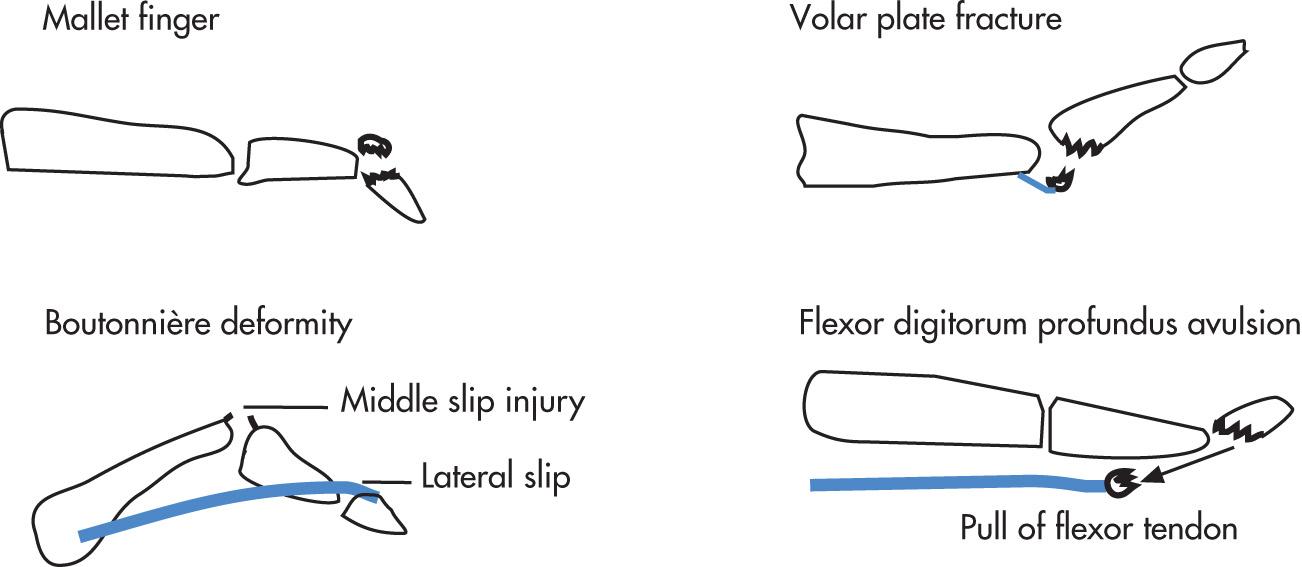
Avulsion of extensor mechanism
DIP flexion with or without avulsion fragment
Avulsion of middle extensor slip at base of middle phalanx
PIP flexion and DIP extension with or without avulsion fragment
Avulsion at volar distal phalanx
DIP cannot be flexed.
Fragment may retract to PIP joint.
Avulsion at base of middle phalanx
PIP hyperextension
Nerve entrapment syndromes:
Carpal tunnel syndrome: most common nerve entrapment in the body, median nerve is compressed in the carpal tunnel. On US and MRI, enlargement of the median nerve >2 mm 2 is seen in the carpal tunnel compared with at the level of the pronator quadratus. Contrast enhancement may be seen on MRI.
Guyon canal syndrome: rare, compression of ulnar nerve by space-occupying lesion in canal. Other causes: extrinsic compression (cyclist's arm), or thrombosis/aneurysm of superficial palmar branch of ulnar artery (hypothenar hammar syndrome)
Acetabular lines and anatomy:
Anterior column includes anterior aspect of the iliac wing, pelvic brim, superior pubic ramus, anterior wall of acetabulum, and teardrop. The column marker on plain radiographs are the iliopubic (iliopectineal line) and pelvic brim.
Posterior column consists of posterior ilium, posterior wall of acetabulum, ischium, medial acetabular wall (quadrilateral plate). The marker on plain radiographs is the ilioischial line: posterior portion of quadrilateral plate of iliac bone.
Teardrop: medial acetabular wall + acetabular notch + anterior portion of quadrilateral plate
Roof of acetabulum
Anterior rim of acetabulum
Posterior rim of acetabulum
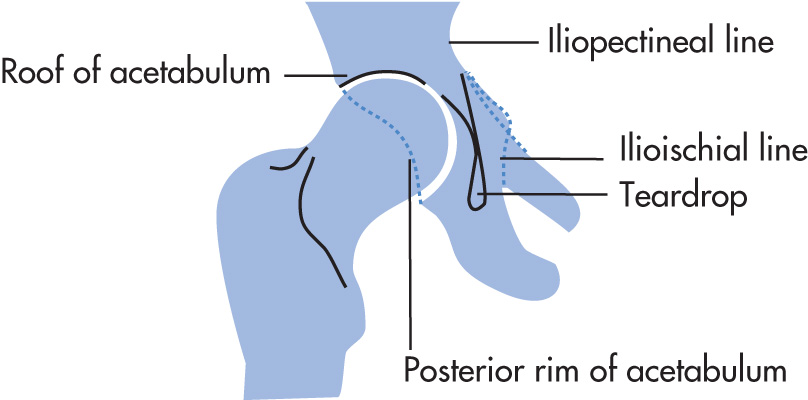
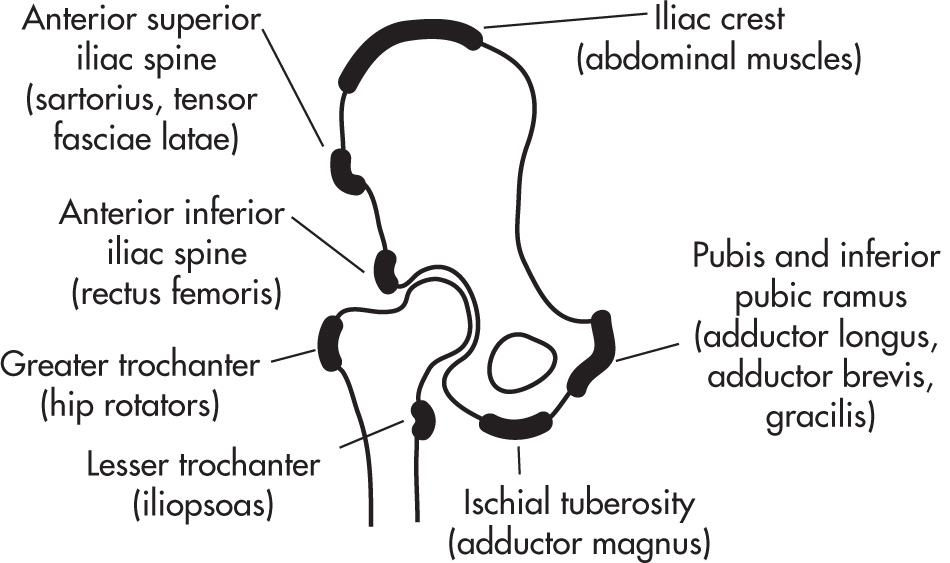
Stable fractures (single break of pelvic ring or peripheral fractures); more common
Avulsion fractures
Anterior superior iliac spine: sartorius avulsion
Anterior inferior iliac spine: rectus femoris avulsion
Ischial tuberosity: hamstring avulsion
Pubis: adductor avulsion
Other fractures
Duverney fracture of iliac wing
Sacral fractures
Fracture of ischiopubic rami: unilateral or bilateral
Wide-swept pelvis: external rotation (anterior compression) injury to one side and an internal rotation (lateral compression) injury to contralateral side
Unstable fractures (pelvic ring interrupted in two places); less common. Significant risks of pelvic organ injury and hemorrhage. All unstable fractures require CT before fixation for more accurate evaluation; the extent of posterior ring disruption is often underestimated by plain radiograph.
Malgaigne fracture: SI joint (or paraarticular fracture) and ipsilateral ischiopubic ramus fracture. Clinically evident by shortening of the lower extremity.
Straddle: involves both obturator rings
Bucket-handle: SI fracture and contralateral ischiopubic ramus fracture
Dislocations
Pelvic ring disruptions and arterial injury
Sources of pelvic hemorrhage include arteries, veins, and osseous structures.
Arterial bleeding is usually from internal iliac artery branches. Frequency in descending order: gluteal, internal pudendal, lateral sacral, and obturator arteries.
High frequency of arterial hemorrhage in AP compression, vertical shear, crushed fracture of sacrum, and fractures extending into greater sciatic notch.
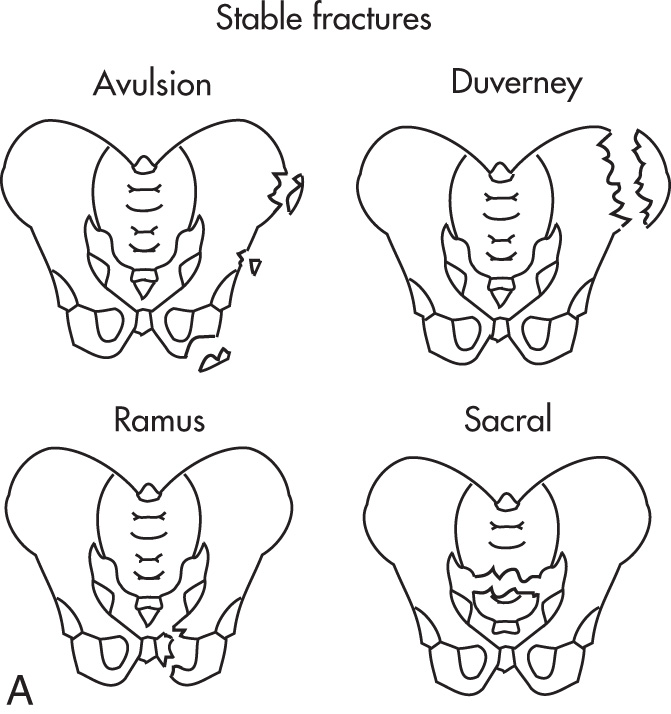
Fracture of the anterior (iliopubic) column
Fracture of the posterior (ilioischial) column
Transverse fracture involving both columns
Complex fracture: T-shaped, stellate
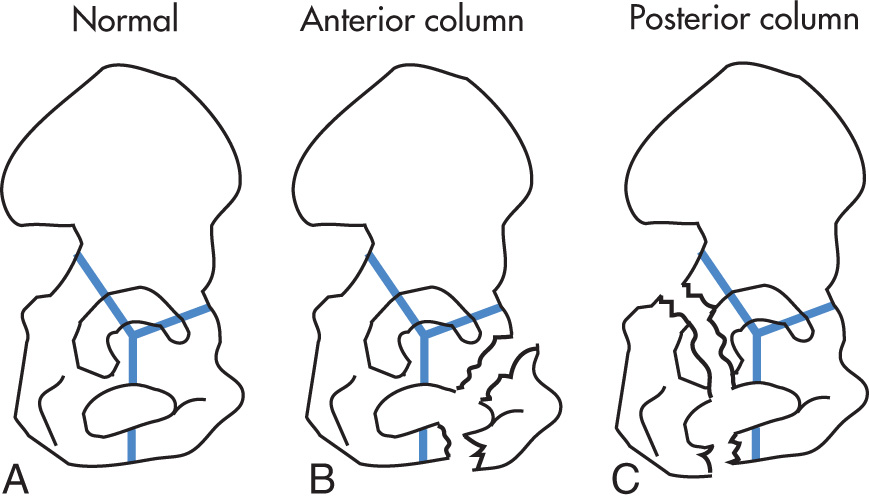
Transverse fracture: direct trauma
Vertical fracture: part of complex pelvic fracture
Stress fractures: usually juxtaarticular and vertical
One useful classification is the Denis classification:
Zone I: lateral to foramina—50% of cases; 6% with neurologic deficit
Zone II: transforaminal—34% of cases; 28% with neurologic deficit
Zone III: central canal involvement—8% of cases; 57% with neurologic deficit
| Origin | Insertion | Nerve | |
|---|---|---|---|
| Flexors (Anterior) | |||
| Iliopsoas | Vertebra/ilium | Lesser trochanter | Femoral, lumbar ventral rami |
| Rectus femoris | Anterior inferior iliac spine | Patellar ligament | Femoral |
| Vagh group | Femur | Patellar ligament | Femoral |
| Sartorius | Anterior superior iliac spine | Medial tibial head | Femoral |
| Pectineus (adducts) | Iliopectineal line | Lesser trochanter | Femoral (obturator occasionally) |
| Extensors (Posterior) | |||
| Adductors | Ischial tuberosity | Femur (adductor tubercle) | Obturator |
| Hamstrings | |||
| Semitendinosus | Ischial tuberosity | Anteromedial tibial shaft | Tibial |
| Semimembranosus | Ischial tuberosity | Posteromedial tibial condyle | Tibial |
| Long head biceps | Ischial tuberosity | Fibular head | Tibial |
| Gluteus | Ilium, sacrum, ligaments | Femur (gluteal tuberosity) | Gluteal |
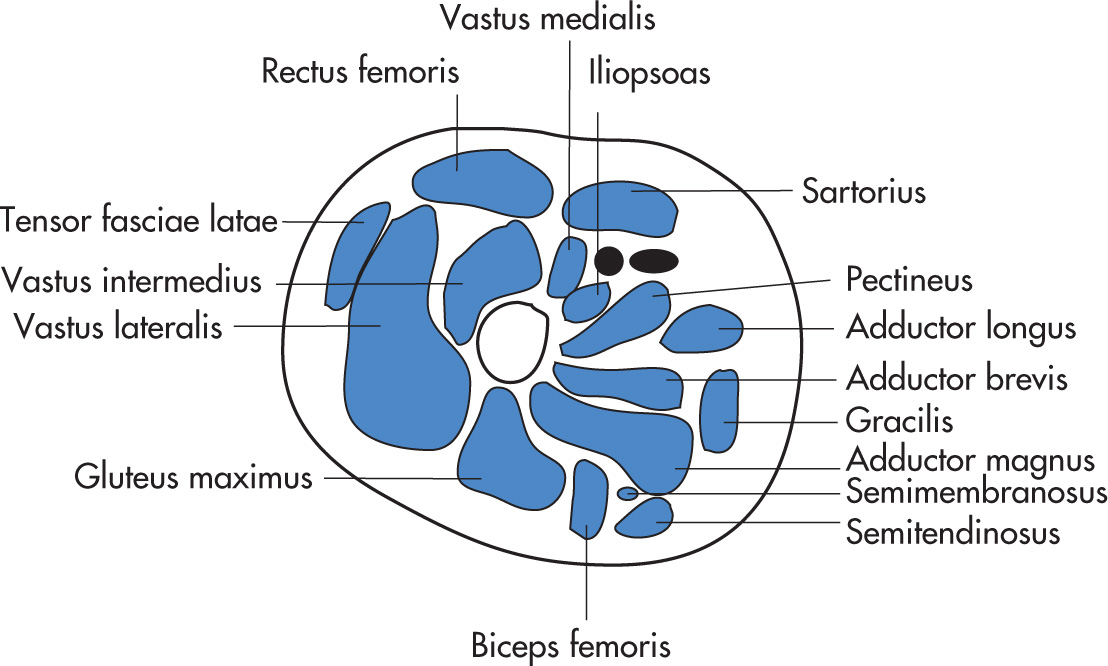
Incidence: 200,000/year in the United States. Fracture incidence increases with age. In the older adult group, mortality is nearly 20%.
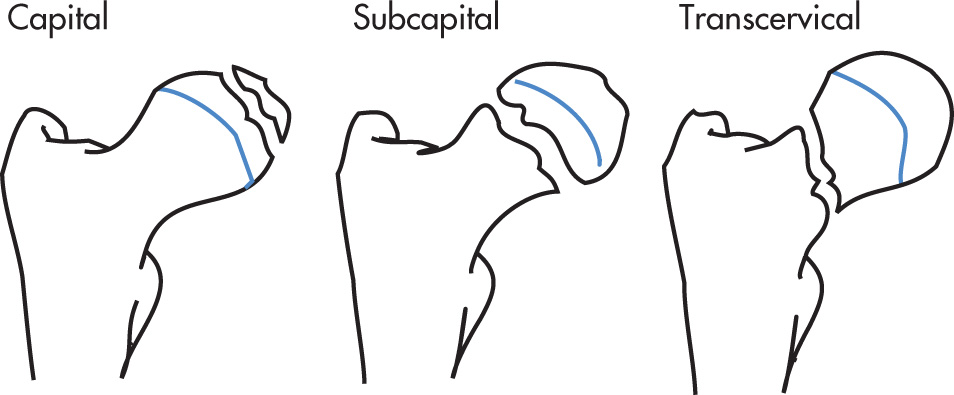
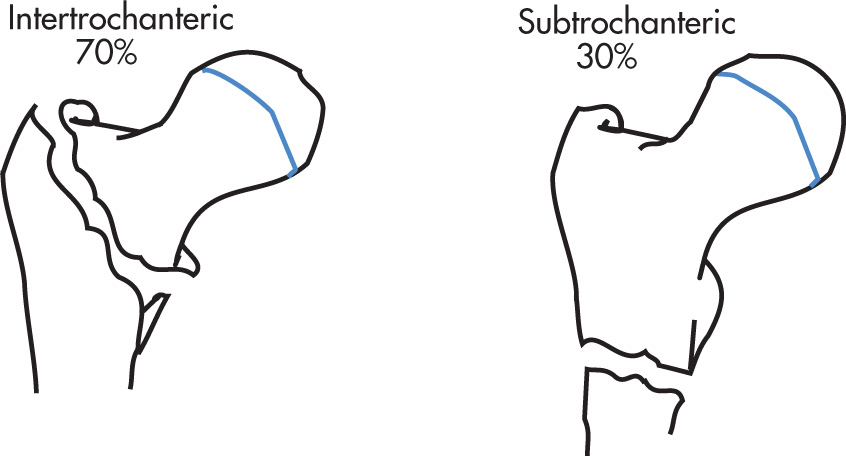
Intracapsular fracture involving femoral head or neck
Capital: uncommon
Subcapital: common
Transcervical: uncommon
Basicervical: uncommon
Extracapsular fracture involving the trochanters
Intertrochanteric
Subtrochanteric
Associated with postmenopausal osteoporosis. Patients often have distal radius and/or proximal humeral fractures.
Garden classification: based on displacement of femoral head; this classification best predicts risk of AVN and nonunion ( Fig. 5.75 )
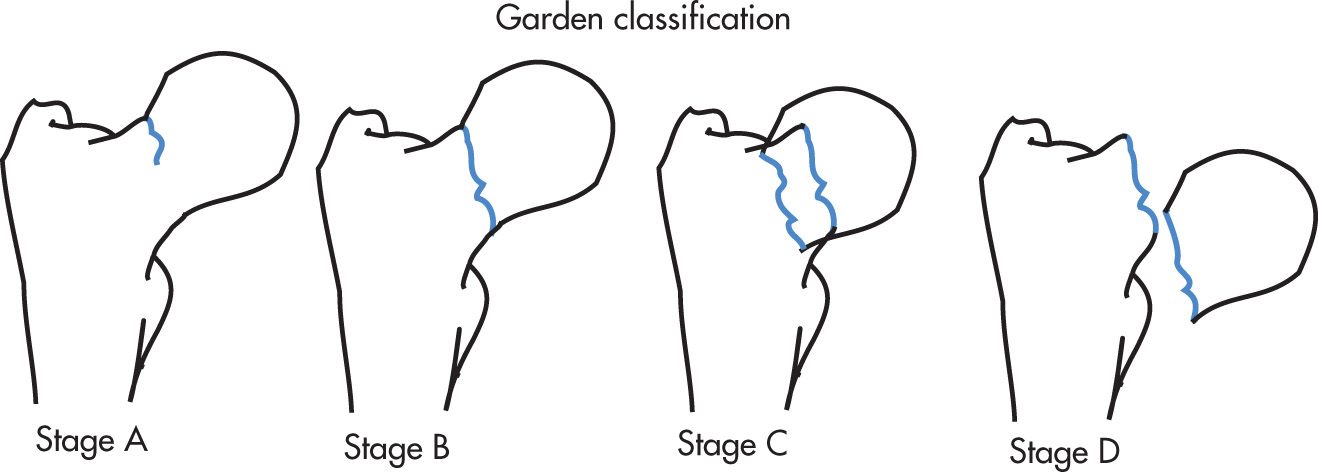
MRI or bone scan helpful if plain radiographs are equivocal
Bed rest: incomplete fractures
Knowles pin
Endoprosthesis if high risk of AVN or nonunion
AVN (in 10%–30% of subcapital fractures) occurs secondary to disruption of femoral circumflex arteries.
Nonunion: obliquity of fracture influences prognosis (steep fractures have higher incidence of nonunion).
Less common than subcapital fractures. Associated with senile osteoporosis.
Simple classification: 2-, 3-, 4-, or multipart fracture, depending on number of fragments and involvement of trochanters
Posteromedial comminution is common
Internal fixation with dynamic compression screw
Valgus osteotomy
AVN is rare.
Coxa vara deformity from failure of internal fixation
Penetration of femoral head hardware as fragments collapse
Arthritis
Lesser trochanter avulsion fracture
Avulsion of iliopsoas in children and adolescents
In adults, isolated less trochanter fracture should raise suspicion for a pathologic fracture (metastatic disease)
Posterior dislocation, 90%
Femoral head lateral and superior to the acetabulum
Femur internally rotated, greater trochanter in profile and lesser trochanter obscured on AP view
Posterior rim of acetabulum is usually fractured
Sciatic nerve injury, 10%
Anterior dislocation, 10%
Femoral head displaced into the obturator, pubic, or iliac region
Internal dislocation
Always associated with acetabular fracture
Femoral head protrudes into pelvic cavity
Femoral stress fracture
Medial femoral neck proximal to lesser trochanter, linear sclerosis or periosteal bone formation can be seen radiographically. MRI is more sensitive and should be obtained if clinical suspicion is high.
Bisphosphonate therapy is associated with stress fractures of the lateral humeral shaft, look for linear sclerosis on radiographs.
Femoroacetabular impingement ( Fig. 5.77 )
Impingement of acetabular labrum and cartilage between femoral head-neck junction and acetabular rim
Cam-type : more common, dysmorphic bulge/overgrowth at the anterolateral femoral head-neck junction
Pincer-type: less common, excessively deep acetabulum, look for cross-over sign (anterior acetabular margin projects lateral to posterior acetabular margin)
Associated with old developmental dysplasia of the hip (DDH) or Legg-calvé-perthes disease

Morel-Lavallée lesion
Degloving injury commonly seen in the lateral proximal thigh and lower back
Subcutaneous fat is detached from muscle fascia
Potentially large, chronic, collections can develop
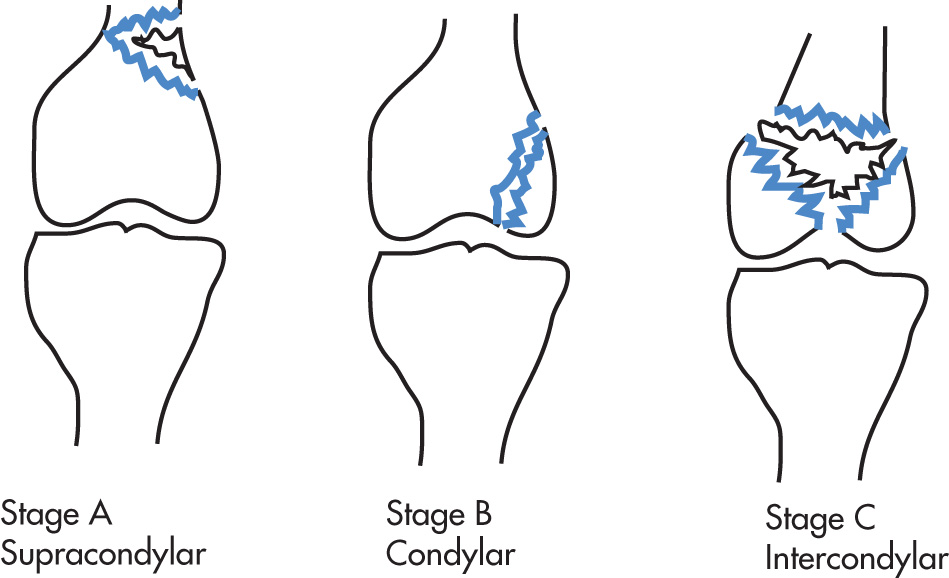
Chronic groin pain in athletes
On MRI, proximal adductor and/or distal rectus abdominis tears, pubic symphisitis/osteitis pubis, medial pubic bone stress injury, or fascia tears of transverse or oblique abdominal muscles, among other causes can be seen.
Dense sclerosis in the medial iliac bones adjacent to SI joints
Typically in young multiparous women (postpartum laxity of pubic symphysis)
Supracondylar
Nondisplaced
Displaced
Impacted
Comminute
Condylar intercondylar
Fender or bumper fracture: knee is struck by moving vehicle. Lateral (80%) plateau fracture is more common because most trauma results from valgus force; medial plateau fractures (10%); 10% combined medial and lateral fractures.
Type 1: split fracture of tibial condyle and proximal fibula (rare)
Type 2: pure depression fracture of either plateau
Type 3: combined types 1 and 2
Type 4: comminuted fracture of both tibial condyles; lateral plateau is usually more severely damaged.
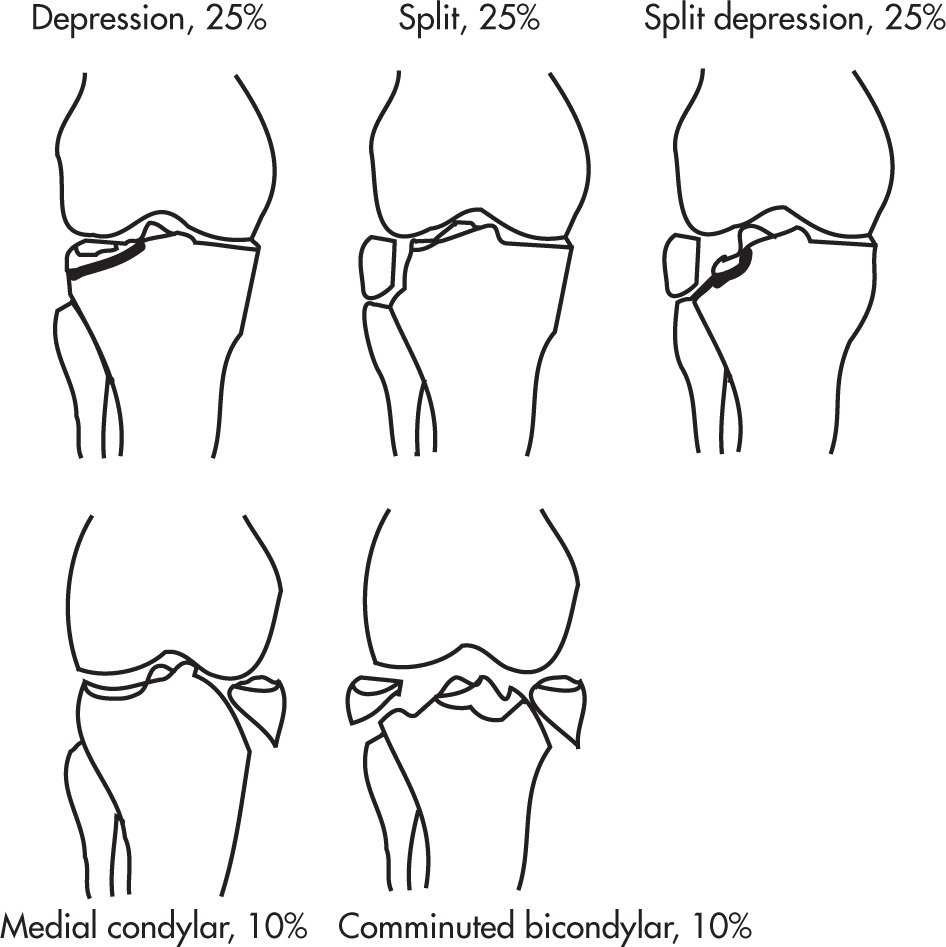
Fractures of tibial plateau may not be obvious; plain radiographs often underestimate the true extent of fractures; therefore CT or tomography in AP and lateral projection is often necessary.
Fat (marrow)-fluid (blood) interface sign (hemarthrosis) on cross-table lateral view
Description of fractures:
Type of fracture: split, depression, etc.
Location: medial, lateral
Number of fragments
Displacement of fragments
Degree of depression
Malunion (common)
Secondary OA (common)
Concomitant ligament and meniscus injuries (i.e., medial collateral ligament [MCL])
Peroneal nerve injury
Classic runner's fracture is most commonly in proximal tibia.
Zone of sclerosis with periosteal reaction
Cortical thickening in posteromedial aspect of proximal tibia
Classification (Hohl and Larson):
Vertical fracture
Transverse (most common)
Comminuted
Avulsed
Differentiation of multipartite patella from fractured patella:
Bipartite or multipartite patella is typically located at the superolateral margin of the patella.
Individual bones of a bipartite or multipartite patella do not fit together as do the fragments of a patellar fracture.
The edges of bipartite or multipartite patella are well corticated.
Shearing, rotary, and tangential impaction forces may result in acute fracture of cartilage (chondral fracture) or cartilage and bone (osteochondral fracture).
Chondral fracture requires arthrography or MRI for visualization.
Osteochondral fracture may be seen by plain radiograph.
Painful, usually unilateral, disease in children and young adults. Results from chronic trauma: a segment of articular cartilage and subchondral bone becomes partially or totally separated. Locations: lateral aspect of medial femoral condyle (75%), medial aspect of medial femoral condyle (10%), lateral aspect of lateral condyle (15%), anterior femoral condyle. Do not confuse osteochondritis dissecans with dorsal defect of patella, which is a benign subchondral lesion of unclear cause, appears as rounded focus of radiolucency with surrounding sclerotic margin at the superolateral aspect of the patella.
Earliest finding: joint effusion
Radiolucent line separating osteochondral body from condyle (advanced stage)
Normal ossification irregularity of posterior condyle may mimic osteochondritis dissecans.
Best evaluated by MRI
The patella normally sits in the trochlear sulcus of the distal femur. The mechanism of dislocation is usually an internal rotation of the femur on a fixed foot. Almost always lateral with disruption of medial retinaculum. Medial facet of patella impacts on anterior lateral femoral condyle.
Plain radiographs can be unremarkable except for joint effusion.
MRI is the imaging modality of choice and shows:
Hemarthrosis
Disruption or sprain of medial retinaculum
Lateral patellar tilt or subluxation
Bone contusions in lateral femoral condyle anteriorly and in medial facet of patella
Osteochondral injuries of patella
Associated injuries to ligaments and menisci in 30%
Overuse syndrome occurring in athletes involved in sports that require kicking, jumping, and running. These activities can place a tremendous stress on the patellofemoral joint, with eventual necrosis, fibrosis, and degeneration of patellar tendon leading to rupture.
MRI is the imaging modality of choice.
Enlarged proximal patellar tendon with areas of increased signal intensity on T1-weighted (T1W) and T2-weighted (T2W) images.
The most commonly injured meniscus is the medial one. The lateral meniscus is less commonly injured because it has greater mobility. Injuries to the lateral meniscus are associated with discoid meniscus.
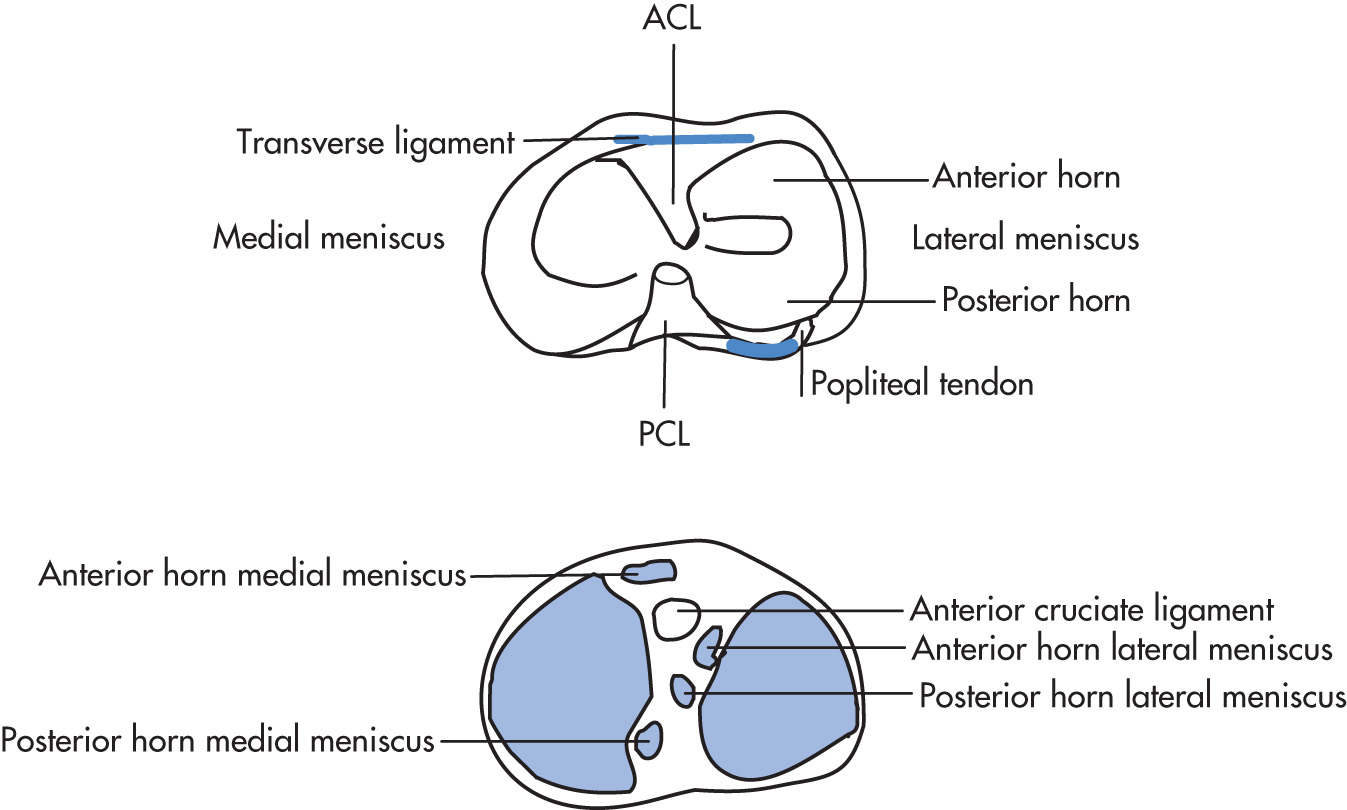
Vertical (longitudinal) tears; most commonly from acute trauma
Horizontal tears (cleavage tears) in older patients: degenerative
Oblique tears
Bucket-handle: may become displaced or detached. There are characteristic signs by MRI: double posterior cruciate ligament (PCL) sign and flipped meniscus sign. The displaced fragment is typically seen within the intercondylar notch.
Peripheral tear: meniscocapsular separation
Truncated meniscus: resorbed or displaced fragment
Type 1: globular increased signal intensity, which does not communicate with articular surface. Pathology: mucinous, hyaline, or myxoid degeneration
Type 2: linear increased signal intensity, which does not extend to articular surface. Pathology: collagen fragmentation with cleft formation
Type 3: tapered apex of meniscus
Type 4: blunted apex of meniscus
Type 5: linear increased signal intensity, which extends to the articular surface. Pathology: tear
Type 6: linear increased signal intensity, which extends to both articular surfaces
Type 7: fragmented, comminuted meniscus
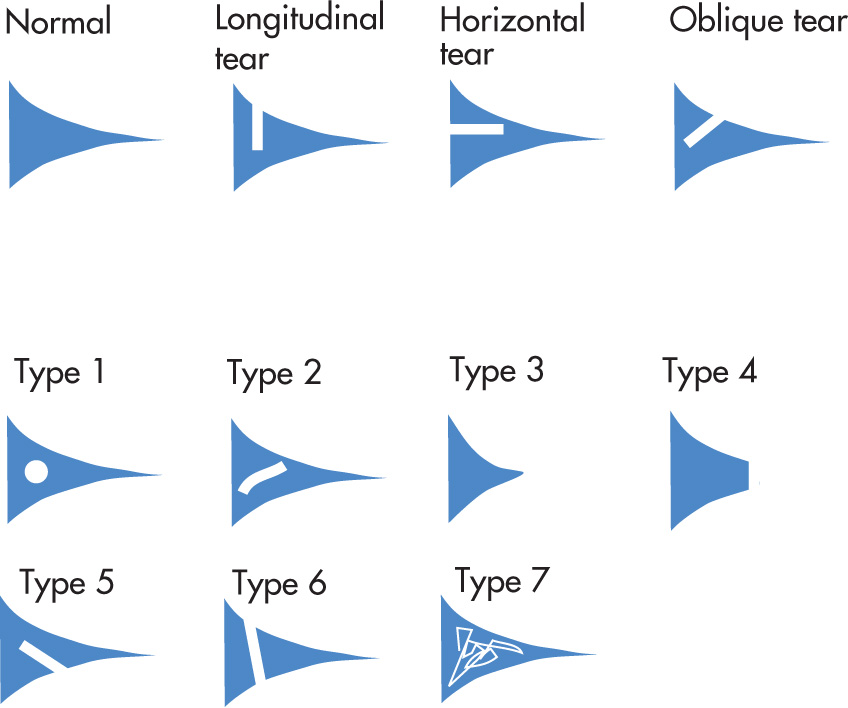
Fibrillatory degeneration of the free concave edge of the meniscal surface is often missed by MRI because of volume averaging.
Normal transverse ligament courses through Hoffa fat pad and may be mistaken for an anterior horn tear. The ligament connects the anterior horns of medial and lateral menisci.
Postmeniscectomy meniscus may have linear signal extending to articular surface as a result of intrameniscal signal.
Pseudotears
Lateral aspect of posterior horn of lateral meniscus (popliteus tendon); medial lateral meniscus (ligament)
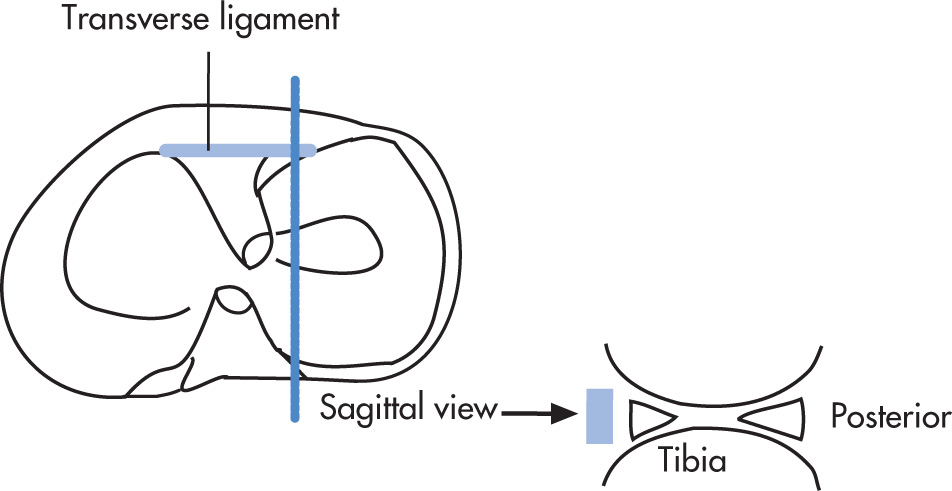
Morphologically enlarged meniscus (normal variant). Clinically presents as clicking of knee on flexion and extension. Diagnosed by MRI if three or more sagittal images show bridging between anterior and posterior horns. Prone to tears; almost always lateral.
Common finding in many diseases (CPPD, hydroxyapatite, hyperparathyroidism [HPT], hemochromatosis, Wilson disease, gout, collagen vascular disease, idiopathic). Meniscal calcification is usually not detectable by MRI.
Formed by insinuation of joint fluid through a meniscal tear into adjacent tissues; therefore meniscal cysts always occur with meniscal tears. Most common in lateral meniscus. Patient presents with knee pain and lateral joint swelling.
The cruciate ligaments are intracapsular and extrasynovial. The anterior cruciate ligament (ACL) limits anterior translation of the tibia and hyperextension. The PCL limits anterior translation of the femur and hyperflexion. ACL tears are far more common than PCL tears and are often associated with other injuries.
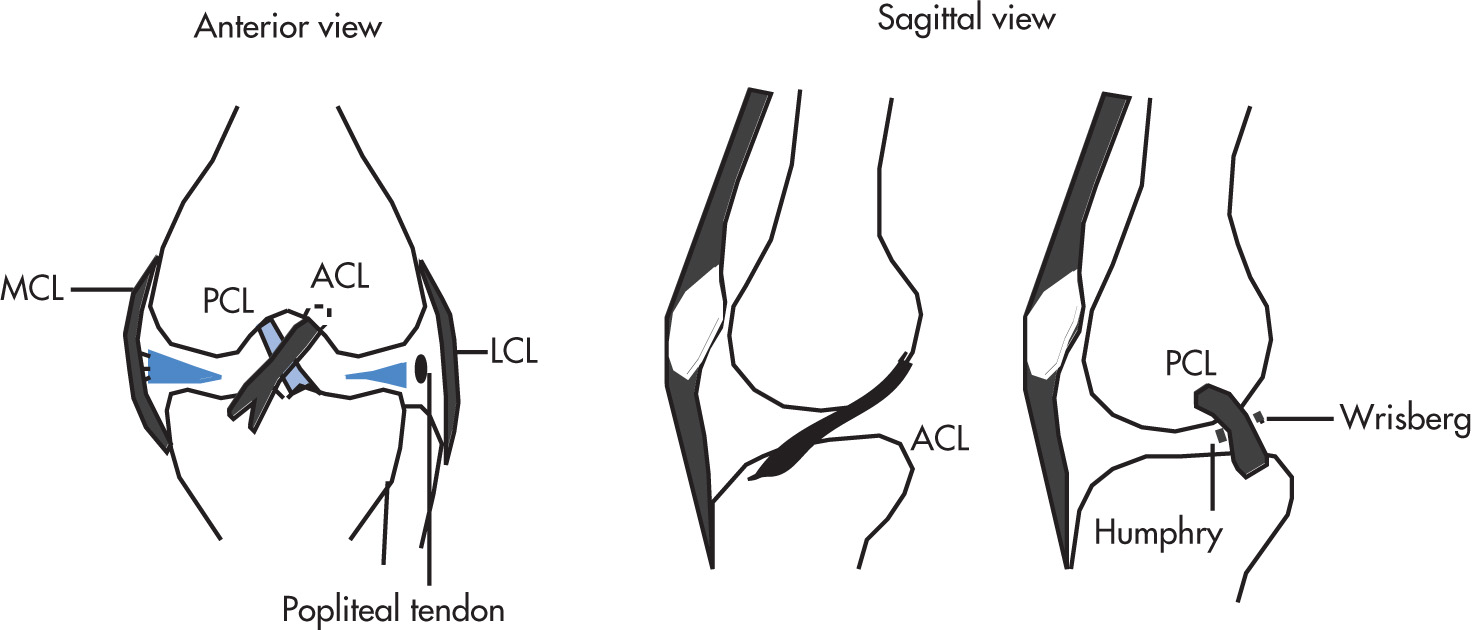
Plain radiographs may show avulsion fragment of intercondylar eminence.
MRI is the study of choice for diagnosing ligamentous injury.
PCL is larger than ACL and better seen by MRI.
MRI is useful for the assessment of complications after ACL reconstruction, including the Cyclops lesion (focal fibrotic nodule in the intercondylar notch).
| Degree of Injury | Direct Signs | Indirect Signs | |
|---|---|---|---|
| Mild sprain | Ligament edema | T2W hyperintensity | |
| Moderate sprain | Partial tear | ACL edema/hemorrhage | Buckling of PCL |
| Some fibers intact | ACL angulation | ||
| Anterior tibial subluxation | |||
| Rupture | Complete tear | Wavy contour | Lateral bone bruise |
| No ACL identified | MCL injury | ||
| ACL discontinuity | Medial meniscal injury | ||
| Edema/hemorrhagic mass | |||
| Chronic injury | Old mild/moderate sprains | Thickened ACL | Anterior tibial subluxation |
| Thinned ACL | |||
| Abnormal proton density signal | |||
| No acute edema on T2W images |
Small avulsion fracture involving the superolateral surface of the proximal tibia. Frequently associated with tears of lateral capsular ligament, ACL, and menisci. Segond fracture is in the midcoronal plane and must be differentiated from less common iliotibial band (ITB) avulsion of Gerdy tubercle seen more anteriorly on the tibia. MRI should be performed in all cases of Segond fracture to evaluate associated ligamentous injury.
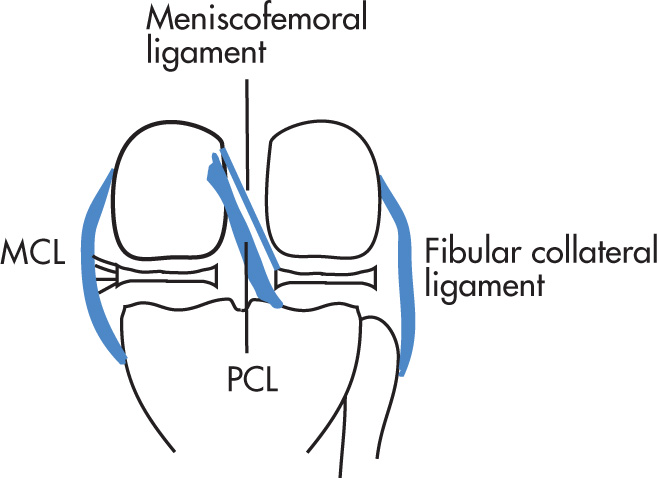
Similar to Segond fracture but the fragment is located on the medial surface of the proximal tibia. Represents avulsion of the deep capsular component of the MCL. Associated with tears of the PCL, avulsions of the PCL from the posterior tibial plateau, and tear of the medial meniscus. MRI should also be performed to evaluate associated injuries.
The MCL (injury common) is attached to the medial meniscus, so both are frequently injured together. The lateral collateral ligament (LCL) complex (injury less common) consists of the fibular collateral ligament, the biceps femoris tendon, and the ITB.
MRI criteria of injury are similar to those used for ACL and PCL tears
O'Donoghue triad (the “unhappy triad”) results from valgus stress with rotation:
ACL tear
MCL injury
Medial meniscal tear (lateral compartment bone bruise)
Pelligrini-Steida lesion: curvilinear calcification or ossification at site of femoral attachment of MCL indicates old MCL injury.
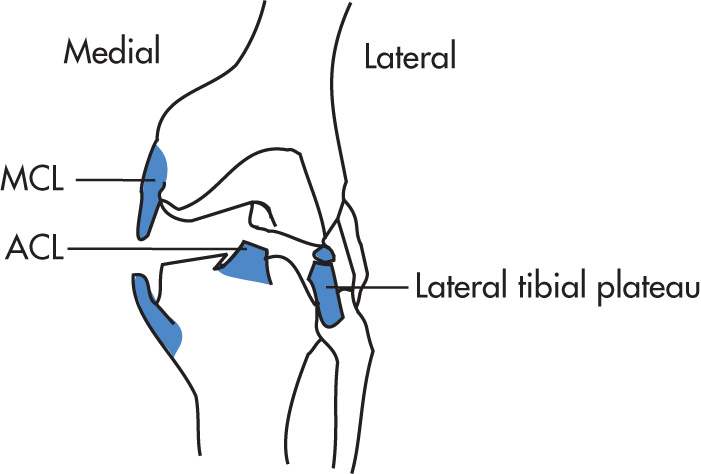
Commonly occurs from acute trauma or overuse injury in athletes or degenerative tendinopathy in older adults.
Acute tendinitis
Tendon enlargement
Fluid in synovial sheath (in tenosynovitis)
Abnormal MRI signal within tendon may indicate partial tear.
Chronic tendinitis
Tendon thinning or thickening
Intratendon signal does not increase on T2W images.
Posterior, 75%
Anterior, 50%
Serious vascular injury to popliteal vessels occurs in 35% and to peroneal vessels in 25%.
ACL at tibial intercondylar eminence
PCL at posterior tibia
ITB at Gerdy tubercle
LCL/biceps femoris at proximal fibula
MCL at femoral or tibial condyles
Patellar tendon at tibial tubercle (chronic avulsion injury in children/adolescents = Osgood-Schlatter disease)
ITB friction syndrome:
Common cause of lateral knee pain in young runners/cyclists
ITB rubs against femoral epicondyle causing irritation and synovial proliferation, MRI demonstrates abnormal signal between these structures and/or superficial to ITB
Posteromedial knee friction syndrome:
Medial knee pain, abnormal MR signal between posteromedial femoral condyle, sartorius and/or gracilis tendons.

Of the different classifications of injuries available, the Weber classification is the most useful. It uses the level of fibular fracture to determine the extent of injury to the tibiofibular ligament complex:
Weber A (below tibiofibular syndesmosis)
Transverse fracture of lateral malleolus or rupture of LCL
Oblique fracture of medial malleolus
Tibiofibular ligament complex spared (stable)
Results from supination-adduction (inversion)
Weber B (through tibiofibular syndesmosis)
Oblique or spiral fracture of lateral malleolus near the joint
Transverse fracture of medial malleolus or rupture of deltoid ligament
Partial disruption of tibiofibular ligament complex
Results from supination-lateral rotation or pronation-abduction
Weber C (above tibiofibular syndesmosis)
Proximal fracture of fibula
Transverse fracture of medial malleolus or rupture of deltoid ligament
Rupture of tibiofibular ligament complex (lateral instability)
Results from pronation-lateral rotation
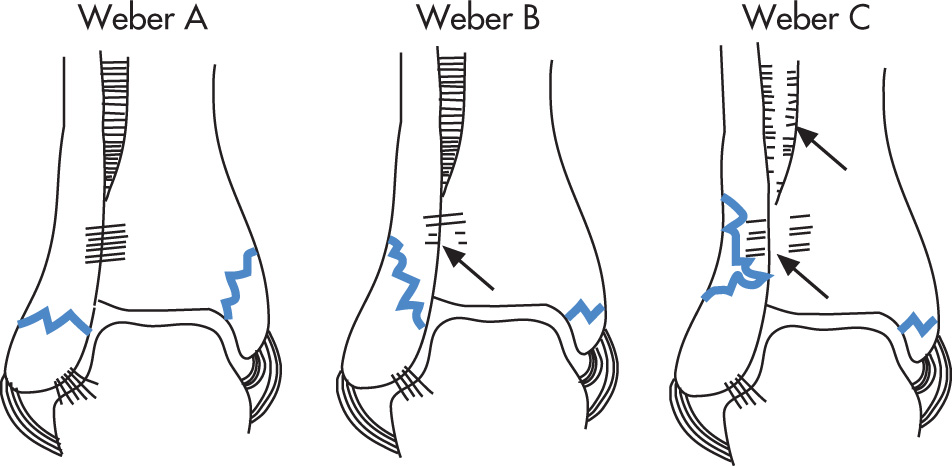
Evaluate all three malleoli.
Assess ankle mortise stability (3- to 4-mm space over entire talus).
If an isolated medial malleolar injury is present, always look for proximal fibular fracture.
Obtain MRI or arthrography for accurate evaluation of ligaments.
Determine if the talar dome is intact.
Supramalleolar fractures of distal tibia that extend into tibial plafond. Usually associated with fractures of distal fibula and/or disruption of distal tibiofibular syndesmosis. Mechanism is usually caused by vertical loading (e.g., in jumpers). Associated with intraarticular comminution. Complication: posttraumatic arthritis.
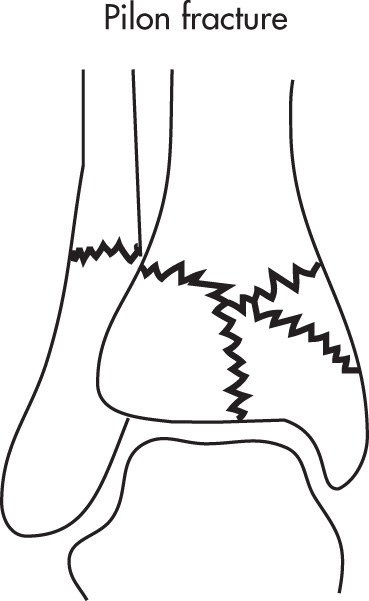
Avulsion of the lateral tibial margin. In children, the juvenile Tillaux fracture is a Salter-Harris type III because the medial growth plate fuses earlier.
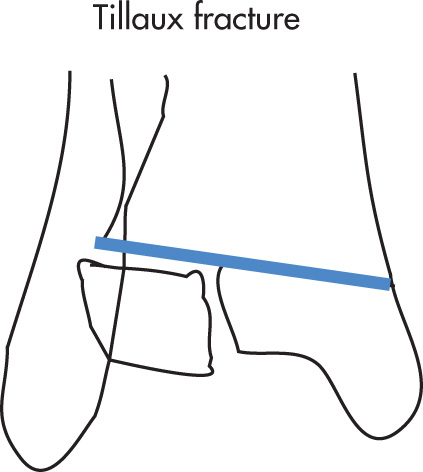
Become a Clinical Tree membership for Full access and enjoy Unlimited articles
If you are a member. Log in here